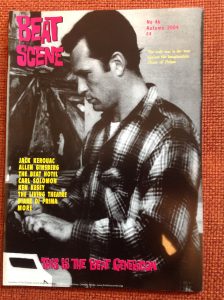
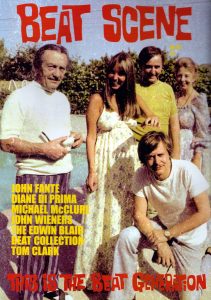
Two issues of Beat Scene from many years ago are now available as digital copies. They are Numbers 46 and 50. See images here. They will be sent as neat PDFs. Anyone interested contact me at kevbeatscene@gmail.com
———————————————————————————–
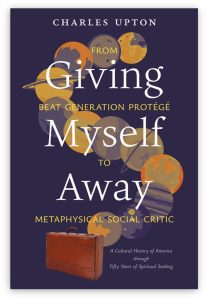 A NEW BOOK FROM THE AUTHOR OF PANIC GRASS. [City Lights Pocket Poets Series No 24, 1968] – CHARLES UPTON, THEN 18, NOW 76. STUDENT OF LEW WELCH. AUTOBIOGRAPHICAL. A BIG BOOK. GIVING MYSELF AWAY: FROM BEAT GENERATION PROTEGE TO METAPHYSICAL CRITIC.
A NEW BOOK FROM THE AUTHOR OF PANIC GRASS. [City Lights Pocket Poets Series No 24, 1968] – CHARLES UPTON, THEN 18, NOW 76. STUDENT OF LEW WELCH. AUTOBIOGRAPHICAL. A BIG BOOK. GIVING MYSELF AWAY: FROM BEAT GENERATION PROTEGE TO METAPHYSICAL CRITIC.
 A very early Beat Scene Press chapbook. Pretty rudimentary in design and layout. This one dates from about 1980, maybe 1979. Chris Challis lived in Leicester in England. Taught at a university. In 1984 he had his QUEST FOR KEROUAC book published by Faber in the UK. A very readable, personal journey as he writes about travelling around America in…. search of Kerouac. There were 100 copies of the chapbook printed. That’s Chris over Kerouac and Bukowski. He loved those guys. It’s essentially Chris telling a story, was it a dream? Can’t recall. Where both Kerouac and Bukowski turn up at his little terraced house one morning and they all go to the local pub. If my memory serves me well. The lettering on the front cover was placed by me using a thing called ‘Letraset.’ Kind of imprint them by rubbing the backs of each individual letter. Time consuming and tricky. An offshoot of this modest chapbook was that we went to a recording studio in Leicester and Chris was recorded reading the story. It came out beautifully. One take. He was a good reader. Think his cigar smoking habit added to the deepness of his voice. We put it out on a cassette and it did well. Chris died a few years later following a fall down the narrow steep stairs of his home.
A very early Beat Scene Press chapbook. Pretty rudimentary in design and layout. This one dates from about 1980, maybe 1979. Chris Challis lived in Leicester in England. Taught at a university. In 1984 he had his QUEST FOR KEROUAC book published by Faber in the UK. A very readable, personal journey as he writes about travelling around America in…. search of Kerouac. There were 100 copies of the chapbook printed. That’s Chris over Kerouac and Bukowski. He loved those guys. It’s essentially Chris telling a story, was it a dream? Can’t recall. Where both Kerouac and Bukowski turn up at his little terraced house one morning and they all go to the local pub. If my memory serves me well. The lettering on the front cover was placed by me using a thing called ‘Letraset.’ Kind of imprint them by rubbing the backs of each individual letter. Time consuming and tricky. An offshoot of this modest chapbook was that we went to a recording studio in Leicester and Chris was recorded reading the story. It came out beautifully. One take. He was a good reader. Think his cigar smoking habit added to the deepness of his voice. We put it out on a cassette and it did well. Chris died a few years later following a fall down the narrow steep stairs of his home.

—————————————————————————————————-
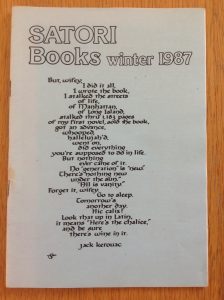
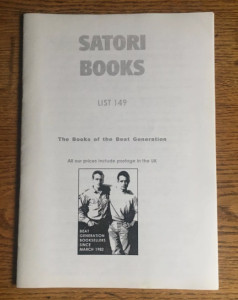 These two catalogues are blasts from the past, the pre-digital age. Satori Books catalogues of Beat type books for sale. None of this Amazon, ABE, internet malarkey where patience, anticipation and a sense of engagement with buying a book through the post was a thing. Instead of a casual click on a computer. You’ll recognise those two chaps on the right for sure and the text on the left. It’s hard not to miss those days. Of course you click and if you’re lucky the package will arrive a few days later. But where’s the fun in that? Someone once said ‘…to travel hopefully is a better thing than to arrive…’ sorry Robert if I’ve mangled that. But you get the drift. Days of a journey across the border – just – into Wales and the brilliant Poetry Bookshop in Broad Street in Hay, or getting Iain Sinclair’s book catalogues from Hackney or further afield Rose Idlet’s Black Ace Books in the USA and best of all a trip to Compendium Books in Camden Town or Duck Soup in London as well. And what a day when a listing came from City Lights. I know Alan Halsey – who ran the Poetry Bookstore in Hay – passed away. Chris Render and Mike Hart from Compendium went to the great bookstore in Heaven, don’t know about Rose Idlet. Iain Sinclair is indestructible into his 80s and shows no sign of slowing down, he’s more likely to be walking faster. And, believe it or not, there are some booksellers who still issue paper catalogues and there are people who see them as essential bibliographic resources, especially those where the bookseller is meticulous in their book descriptions. I’ve a number of those here and they are brilliant for fine detail.
These two catalogues are blasts from the past, the pre-digital age. Satori Books catalogues of Beat type books for sale. None of this Amazon, ABE, internet malarkey where patience, anticipation and a sense of engagement with buying a book through the post was a thing. Instead of a casual click on a computer. You’ll recognise those two chaps on the right for sure and the text on the left. It’s hard not to miss those days. Of course you click and if you’re lucky the package will arrive a few days later. But where’s the fun in that? Someone once said ‘…to travel hopefully is a better thing than to arrive…’ sorry Robert if I’ve mangled that. But you get the drift. Days of a journey across the border – just – into Wales and the brilliant Poetry Bookshop in Broad Street in Hay, or getting Iain Sinclair’s book catalogues from Hackney or further afield Rose Idlet’s Black Ace Books in the USA and best of all a trip to Compendium Books in Camden Town or Duck Soup in London as well. And what a day when a listing came from City Lights. I know Alan Halsey – who ran the Poetry Bookstore in Hay – passed away. Chris Render and Mike Hart from Compendium went to the great bookstore in Heaven, don’t know about Rose Idlet. Iain Sinclair is indestructible into his 80s and shows no sign of slowing down, he’s more likely to be walking faster. And, believe it or not, there are some booksellers who still issue paper catalogues and there are people who see them as essential bibliographic resources, especially those where the bookseller is meticulous in their book descriptions. I’ve a number of those here and they are brilliant for fine detail.
—————————————————————————————-
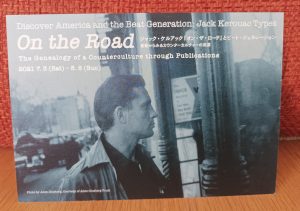 A fairly well known photograph of Jack Kerouac – it was used on the cover of a very big book of photos by Allen Ginsberg a few years back. BEAT MEMORIES was it? A variant of this picture for sure. The postcard included a note from Beat Generation aficionado Dave Olson in Japan. You may have seen his Youtube Beat Generation short films where he runs through a ton of Beat Stuff, books, photos, all sorts, outlining links, salient points. He’s a goldmine of information. Look for him ‘The Genealogy of a Counterculture Through Publications.’ That’s one of his things. Think – from memory – this picture of Jack was taken near Tompkins Square Park in NYC.
A fairly well known photograph of Jack Kerouac – it was used on the cover of a very big book of photos by Allen Ginsberg a few years back. BEAT MEMORIES was it? A variant of this picture for sure. The postcard included a note from Beat Generation aficionado Dave Olson in Japan. You may have seen his Youtube Beat Generation short films where he runs through a ton of Beat Stuff, books, photos, all sorts, outlining links, salient points. He’s a goldmine of information. Look for him ‘The Genealogy of a Counterculture Through Publications.’ That’s one of his things. Think – from memory – this picture of Jack was taken near Tompkins Square Park in NYC.
—————————————————————————————–
 A long ago French language edition of Jack Kerouac’s THE SUBTERRANEANS. Some of the European editions of his books have attractive designs, some frankly odd ones too. This one has a simple approach, the period American car, a typical gas guzzler of the era. The petrol, sorry, gas station. It tells a story all of its own. Is it the one that Jack Kerouac might have gone along with? He was interested in how his books were presented, evidence of this is in the rough sketches he submitted to various publishers, Viking included, relating to possible book covers. He was no painter by any stretch and it’s difficult to see any design department of a publisher would have paid much heed. There’s no Dean or Sal on show here. Maybe the intent is to convey movement, transit, the highway. It works. It’s immediate. The message hits you in a flash. A kind of ‘satori.’ A sudden illumination.
A long ago French language edition of Jack Kerouac’s THE SUBTERRANEANS. Some of the European editions of his books have attractive designs, some frankly odd ones too. This one has a simple approach, the period American car, a typical gas guzzler of the era. The petrol, sorry, gas station. It tells a story all of its own. Is it the one that Jack Kerouac might have gone along with? He was interested in how his books were presented, evidence of this is in the rough sketches he submitted to various publishers, Viking included, relating to possible book covers. He was no painter by any stretch and it’s difficult to see any design department of a publisher would have paid much heed. There’s no Dean or Sal on show here. Maybe the intent is to convey movement, transit, the highway. It works. It’s immediate. The message hits you in a flash. A kind of ‘satori.’ A sudden illumination.
 Another French aspect found again this morning. A postcard depicting ‘Jack & Neal’. Apparently it’s by Billy Leliveld. The postmark on the card says 19 December 1983. It was posted in Edinburgh by ‘Marie.’ Marie tells me she is sorry to have missed the Jack Kerouac event in Northampton a few weeks before. It was quite something. The card was a typical way back then of — keeping in touch. The Whats App of its day I guess. It had a charm all of its own. Hope Marie is still ok. Once again crucial elements in the design, the all important car. Did Kerouac even have a driving licence? The Stars and Stripes flag, airbrushed images of Jack and Neal. Remember, images of Kerouac and especially Neal were not so prevalent 40 + years ago. and note the plates on the car JKNC 5719. It’s a beautiful card, if a touch over romanticised.
Another French aspect found again this morning. A postcard depicting ‘Jack & Neal’. Apparently it’s by Billy Leliveld. The postmark on the card says 19 December 1983. It was posted in Edinburgh by ‘Marie.’ Marie tells me she is sorry to have missed the Jack Kerouac event in Northampton a few weeks before. It was quite something. The card was a typical way back then of — keeping in touch. The Whats App of its day I guess. It had a charm all of its own. Hope Marie is still ok. Once again crucial elements in the design, the all important car. Did Kerouac even have a driving licence? The Stars and Stripes flag, airbrushed images of Jack and Neal. Remember, images of Kerouac and especially Neal were not so prevalent 40 + years ago. and note the plates on the car JKNC 5719. It’s a beautiful card, if a touch over romanticised.
 Found in a scrapbook this morning. Believe this was taken from the Time Out London magazine listings of the period. The much respected BBC Arena documentary all about Jack Kerouac. Directed by Richard Lerner. It was a big thing. Opened a lot of eyes about Kerouac. The film was first aired in the mid 1980s. There was home movie footage of him playing pool, a middle aged fellow, a few steps along from his prime. Years of alcohol abuse taking a toll on him. He’s burly, yet he seems outwardly happy, if happy he really is. The film was well received. It may have dismayed some, his decline in evidence. Sad to note that the film was made with the guiding hand of series editor recently deceased Alan Yentob.
Found in a scrapbook this morning. Believe this was taken from the Time Out London magazine listings of the period. The much respected BBC Arena documentary all about Jack Kerouac. Directed by Richard Lerner. It was a big thing. Opened a lot of eyes about Kerouac. The film was first aired in the mid 1980s. There was home movie footage of him playing pool, a middle aged fellow, a few steps along from his prime. Years of alcohol abuse taking a toll on him. He’s burly, yet he seems outwardly happy, if happy he really is. The film was well received. It may have dismayed some, his decline in evidence. Sad to note that the film was made with the guiding hand of series editor recently deceased Alan Yentob.
 Delving into another box, a little break from finishing off preparing Beat Scene issue number 113 for the printer in a few days, this compact disc WILLIAM S. BURROUGHS AMSTERDAM TRIBUTE EVENING September 23, 1994, came to light. Organised by someone called Ben Posset and held at the famous Milky Way – [recall my one and only time in Holland – as I knew it then – and discovering this place – over 55 years ago as a teenager] They made a CD recording of it. Eddie Woods was there, he has always been a figure around the Beats, keeping that world alive. Udo Breger, another longtime conspirator, Ira Cohen, sure he needs no introduction, Jurgen Ploog, a regular name on Planet Burroughs. Klaus Maeck and William Levy as well. Curiously there is something – a dialogue between Eddie Woods – standing in as Burroughs and Johannes van Dam as Allen Ginsberg. And a real bonus – Burroughs on the telephone from Lawrence in Kansas. Nowadays it would be WSB via Zoom or somesuch media which is a mystery to me. The 1990s was a time when the Beats as living beings were disappearing from our world. Like prehistoric creatures they were becoming extinct. This little compact disc, it somehow made me think of those very deep rods inserted into the earth so far, by environmentalist/scientists – which tell us what life was like so many years ago, even aeons ago. Already this CD is touching thirty years old. How time flashes by.
Delving into another box, a little break from finishing off preparing Beat Scene issue number 113 for the printer in a few days, this compact disc WILLIAM S. BURROUGHS AMSTERDAM TRIBUTE EVENING September 23, 1994, came to light. Organised by someone called Ben Posset and held at the famous Milky Way – [recall my one and only time in Holland – as I knew it then – and discovering this place – over 55 years ago as a teenager] They made a CD recording of it. Eddie Woods was there, he has always been a figure around the Beats, keeping that world alive. Udo Breger, another longtime conspirator, Ira Cohen, sure he needs no introduction, Jurgen Ploog, a regular name on Planet Burroughs. Klaus Maeck and William Levy as well. Curiously there is something – a dialogue between Eddie Woods – standing in as Burroughs and Johannes van Dam as Allen Ginsberg. And a real bonus – Burroughs on the telephone from Lawrence in Kansas. Nowadays it would be WSB via Zoom or somesuch media which is a mystery to me. The 1990s was a time when the Beats as living beings were disappearing from our world. Like prehistoric creatures they were becoming extinct. This little compact disc, it somehow made me think of those very deep rods inserted into the earth so far, by environmentalist/scientists – which tell us what life was like so many years ago, even aeons ago. Already this CD is touching thirty years old. How time flashes by.
——————————————————————————————————
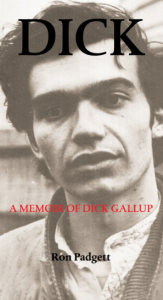 Dick Gallup. A name that seems important in that very late 1950s – 1960s era of new wave American poets gravitating towards New York City – Gallup came from Oklahoma – and being part of that New York School of modern US poetry that first saw light in little indie mimeograph magazines. Think Ted Berrigan [the bloke who took the time to go with Aram Saroyan and Lewis MacAdams to go and interview for The Paris Review – the fading Jack Kerouac in his last years], think Anne Waldman, Lewis Warsh, Joe Brainard, Philip Guston, Tom Clark, LeRoi Jones, Joel Oppenheimer, Barbara Guest, John Ashbery, Ron Padgett and so many other poets. There is a new book – reading it now – DICK: A MEMOIR OF DICK GALLUP – it is written by his fellow Oklahoma poet pal Ron Padgett – lifelong friends. The book is episodic, Ron Padgett recalling events, broken down to the essential, giving a picture of this enigma of a man. A blurb on the back cover tells us – “…Padgett provides a master class about how to convey the complexities of friendship. Insightful, humorous, anecdotally rich and ruefully honest…” Yes, I’d go along with that. Still reading it. [Cuneiform Press]
Dick Gallup. A name that seems important in that very late 1950s – 1960s era of new wave American poets gravitating towards New York City – Gallup came from Oklahoma – and being part of that New York School of modern US poetry that first saw light in little indie mimeograph magazines. Think Ted Berrigan [the bloke who took the time to go with Aram Saroyan and Lewis MacAdams to go and interview for The Paris Review – the fading Jack Kerouac in his last years], think Anne Waldman, Lewis Warsh, Joe Brainard, Philip Guston, Tom Clark, LeRoi Jones, Joel Oppenheimer, Barbara Guest, John Ashbery, Ron Padgett and so many other poets. There is a new book – reading it now – DICK: A MEMOIR OF DICK GALLUP – it is written by his fellow Oklahoma poet pal Ron Padgett – lifelong friends. The book is episodic, Ron Padgett recalling events, broken down to the essential, giving a picture of this enigma of a man. A blurb on the back cover tells us – “…Padgett provides a master class about how to convey the complexities of friendship. Insightful, humorous, anecdotally rich and ruefully honest…” Yes, I’d go along with that. Still reading it. [Cuneiform Press]
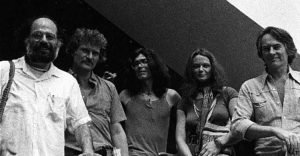 Naropa, 1976 – L-R – Allen Ginsberg, John Ashbery, Dick Gallup, Anne Waldman, Michael McClure
Naropa, 1976 – L-R – Allen Ginsberg, John Ashbery, Dick Gallup, Anne Waldman, Michael McClure
——————————————————————————————
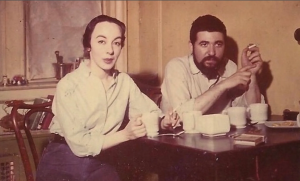
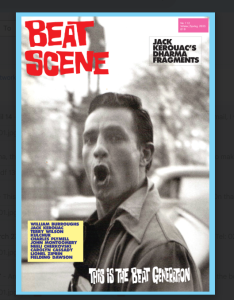
Who are these people and what are they doing in Beat Scene issue No 112? WHICH IS OUT NOW. [copies are being mailed out on a daily basis. Please bear with me, one pair of hands and all that.]Find out if you subscribe or order a single copy by contacting me – Kevin Ring – at kevbeatscene@gmail.com
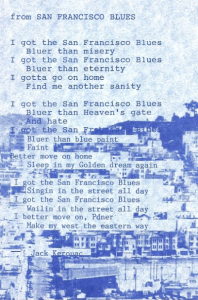 A little Jack Kerouac postcard – it was issued in Arthur and Kit Knight’s ‘The Unspeakable Visions of The Individual’ series in the 1970s and 1980s. Abbreviated to TUVOTI for simplicity. The card displayed a fragment of Kerouac’s unpublished writing at the time. It has since become evident that he wrote far more than anyone could have ever imagined. San Francisco Blues, his collection of haiku like poetry, remained unpublished until the 1980s when it was published in a bootleg edition by fans eager to see it in print, at a point when nobody seemed interested. The postcard, double sided, was all part of a very important series of Beat books that not only kept Kerouac’s name alive in the doldrum years, but actually played a significant role in reinvigorating his reputation. To the point where he became, in the public’s eyes, a seriously considered writer and not the ridiculous ‘King of the Beats’ – as some would have it. Arthur and Kit Knight deserve much respect.
A little Jack Kerouac postcard – it was issued in Arthur and Kit Knight’s ‘The Unspeakable Visions of The Individual’ series in the 1970s and 1980s. Abbreviated to TUVOTI for simplicity. The card displayed a fragment of Kerouac’s unpublished writing at the time. It has since become evident that he wrote far more than anyone could have ever imagined. San Francisco Blues, his collection of haiku like poetry, remained unpublished until the 1980s when it was published in a bootleg edition by fans eager to see it in print, at a point when nobody seemed interested. The postcard, double sided, was all part of a very important series of Beat books that not only kept Kerouac’s name alive in the doldrum years, but actually played a significant role in reinvigorating his reputation. To the point where he became, in the public’s eyes, a seriously considered writer and not the ridiculous ‘King of the Beats’ – as some would have it. Arthur and Kit Knight deserve much respect.
———————————————————————————————-
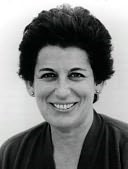 In the not too distant future there will be a new bigger format Beat Scene Press chapbook by Ann Charters – JACK KEROUAC’S LEGENDARY WORLD OF DULUOZ. It will be in an edition of possibly 200 copies. Each one numbered. There will be photographs. The work is previously unpublished. As you will undoubtedly know, Ann Charters has been the go to Jack Kerouac scholar for decades, ever since she compiled his bibliography for publication through The Phoenix Bookstore after visiting him in the later 1960s at his home in Hyannis. Then followed that up with a biography of him, published in 1973, without the help of the Jack Kerouac archives, she was denied access. That was the state of affairs then. The vault doors were well and truly locked. If you are interested in this publication get in touch with me at kevbeatscene@gmail.com
In the not too distant future there will be a new bigger format Beat Scene Press chapbook by Ann Charters – JACK KEROUAC’S LEGENDARY WORLD OF DULUOZ. It will be in an edition of possibly 200 copies. Each one numbered. There will be photographs. The work is previously unpublished. As you will undoubtedly know, Ann Charters has been the go to Jack Kerouac scholar for decades, ever since she compiled his bibliography for publication through The Phoenix Bookstore after visiting him in the later 1960s at his home in Hyannis. Then followed that up with a biography of him, published in 1973, without the help of the Jack Kerouac archives, she was denied access. That was the state of affairs then. The vault doors were well and truly locked. If you are interested in this publication get in touch with me at kevbeatscene@gmail.com
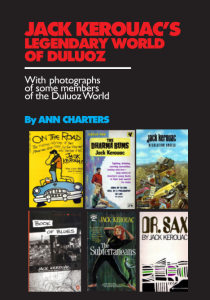
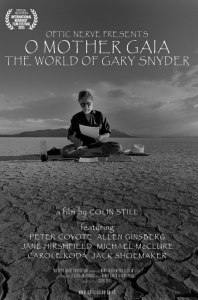 Excuse me. I couldn’t resist. If you’re going to San Francisco — this coming weekend – or even if you live thereabouts, why not head over to the San Rafael Film Center to see Colin Still’s Gary Snyder film Oh Mother Gaia: The World of Gary Snyder. It’s being screened at 4.30 PM on Sunday March 9. Colin Still is based in London and has long documented the Beat Generation on film. Gary Snyder, Michael McClure, Robert Creeley, Jerome Rothenberg, Frank O’Hara, Allen Ginsberg and many others. You’ll find plenty to see at his Optic Nerve site. And, incidentally, his Jerome Rothenberg film is being screened in Glasgow later on March 22. Here’s a link to that Gary Snyder film. https://rafaelfilm.cafilm.org/o-mother-gaia/
Excuse me. I couldn’t resist. If you’re going to San Francisco — this coming weekend – or even if you live thereabouts, why not head over to the San Rafael Film Center to see Colin Still’s Gary Snyder film Oh Mother Gaia: The World of Gary Snyder. It’s being screened at 4.30 PM on Sunday March 9. Colin Still is based in London and has long documented the Beat Generation on film. Gary Snyder, Michael McClure, Robert Creeley, Jerome Rothenberg, Frank O’Hara, Allen Ginsberg and many others. You’ll find plenty to see at his Optic Nerve site. And, incidentally, his Jerome Rothenberg film is being screened in Glasgow later on March 22. Here’s a link to that Gary Snyder film. https://rafaelfilm.cafilm.org/o-mother-gaia/
Here’s the Optic Nerve link – https://www.opticnerve.co.uk
And, before it is forgotten – a link to the Jerome Rothenberg event and Colin Still’s film – https://www.eventbrite.co.uk/e/jerome-rothenberg-anthology-as-manifesto-tickets-1140887387889
—————————————————————————————-
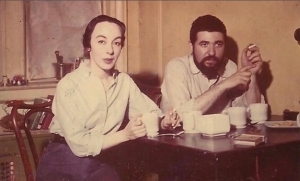
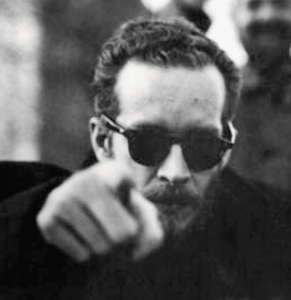
The Beat Generation. Where does it begin and end? Does it begin, does it end? We all know and readily recognise and embrace the ‘names’ – Allen Ginsberg, William Burroughs, Neal Cassady, Jack Kerouac and all the others. Ginsberg, some would have it that the Beat Generation was largely a figment of his wild imagination. It does seem as though the idea of such a thing was his alone, the often arch promoter of his fellow friends and writers. But, if you dig deep enough, you will discover that Jack Kerouac often fully embraced the notion [other times he felt it only existed briefly in the 1940s]. Who do you include if you concede that yes it did exist in some fluid form? That conversation could go on forever. Through contact with Joao Faustino in recent times I’ve discovered someone called Lionel Ziprin. [see him above with his wife Joanna]. I’d never heard of him until now. But slowly I’ve read of who he was, what he did, who he connected with and suchlike. You might say Lionel Ziprin existed in a ‘Bohemian Generation’ rather than a Beat Generation – but is that being pernickety about it all? Ziprin reintroduced me to Harry Smith, [See Harry above pointing the finger] a figure who has only come through the doors at Beat Scene magazine fleetingly. Always connected with Allen Ginsberg, who seems to have housed, fed and sponsored Harry Smith over decades. Seemingly seeing a talent that needed nurturing. There’s a connectedness existing between Lionel Ziprin and Harry Smith, music archivist, musicologist [a funny latterday label if ever there was] experimental film maker – is he there with Bruce Connor and Stan Brakhage et al? They were friends, collaborators and it could be there are avenues to be walked down and explored there. Joao Faustino’s fascinations have taken me down some alleyways and over the weekend to this interview by Raymond Foye. See what you think. https://gagosian.com/quarterly/2023/11/17/interview-art-of-biography-cosmic-scholar-the-life-and-times-of-harry-smith/?utm_source=Gagosian&utm_campaign=9d0d114fd6-quarterly-nov-2023-highlights&utm_medium=email&utm_term=0_-6251223ca5-%5BLIST_EMAIL_ID%5D
————————————————————————————————————-
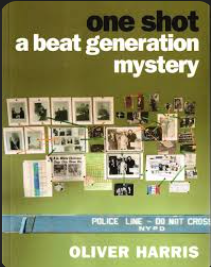 Every now and then something comes along that lifts the days out of the ordinary. In these gloomy January times that something is ONE SHOT: A BEAT GENERATION MYSTERY by William Burroughs scholar of long standing Oliver Harris. That ‘one shot’ is a black and white photograph. It depicts Hal Chase [sometimes] alongside Jack Kerouac, Allen Ginsberg and one William Burroughs. They are all so very young. Burroughs the oldest at just thirty one years old. Not wanting to spill many beans and spoil this ‘Beat Generation Mystery’ there are no ‘spoilers here. This book needs to be read by all Beat Generation readers. Of course, Burroughs is a central character. We’re looking back 80 years now to the day this photo was taken and the reasons why it now takes on increased significance. Oliver Harris takes the reader on a journey, the history of this photograph, and even more importantly, the backstory of it. The who, the what, the when. There are discoveries, there are dead ends, possibilities. One can picture Oliver Harris staring into this old image, looking for clues – of course it is something he does most days, researching the life of William Burroughs. And, this iconic photo – after reading this account – is it ever more iconic – sent Harris into his own past. It must easily be his most personal publication, Burroughs and company on a Winter’s day, close to the environs of New York City’s Columbia University and yet so close to his own life story. Yet he sticks to the task, levels of forensic diligence, doggedness, hopeful research, weather forecasts in the NYC area in the mid 1940s. He speaks of intersections all the way through, and just like Iain Sinclair, another who will go the extra miles in search of stuff, [literally, both of them] – there are diversions, digressions. He takes Beat Generation research to possibly greater heights than we have previously encountered. And yes, there are definitive conclusions, both for the photograph and Oliver Harris. Just fabulous.
Every now and then something comes along that lifts the days out of the ordinary. In these gloomy January times that something is ONE SHOT: A BEAT GENERATION MYSTERY by William Burroughs scholar of long standing Oliver Harris. That ‘one shot’ is a black and white photograph. It depicts Hal Chase [sometimes] alongside Jack Kerouac, Allen Ginsberg and one William Burroughs. They are all so very young. Burroughs the oldest at just thirty one years old. Not wanting to spill many beans and spoil this ‘Beat Generation Mystery’ there are no ‘spoilers here. This book needs to be read by all Beat Generation readers. Of course, Burroughs is a central character. We’re looking back 80 years now to the day this photo was taken and the reasons why it now takes on increased significance. Oliver Harris takes the reader on a journey, the history of this photograph, and even more importantly, the backstory of it. The who, the what, the when. There are discoveries, there are dead ends, possibilities. One can picture Oliver Harris staring into this old image, looking for clues – of course it is something he does most days, researching the life of William Burroughs. And, this iconic photo – after reading this account – is it ever more iconic – sent Harris into his own past. It must easily be his most personal publication, Burroughs and company on a Winter’s day, close to the environs of New York City’s Columbia University and yet so close to his own life story. Yet he sticks to the task, levels of forensic diligence, doggedness, hopeful research, weather forecasts in the NYC area in the mid 1940s. He speaks of intersections all the way through, and just like Iain Sinclair, another who will go the extra miles in search of stuff, [literally, both of them] – there are diversions, digressions. He takes Beat Generation research to possibly greater heights than we have previously encountered. And yes, there are definitive conclusions, both for the photograph and Oliver Harris. Just fabulous.
ISBN 978-3-910431-58-4
Published by Moloko Print – https://www.molokoplusrecords.de/finder.php?folder=Print&content=298
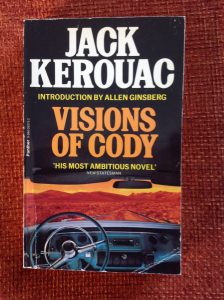 David Button kindly told me about this conversation regarding Jack Kerouac and his book Visions of Cody. Don’t know of David Keenan but after listening to him speak passionately about this book I want to know more. Remember Kerouac fervently hoped it would be published in his lifetime, but it never was [excepting a few thousand words via New Directions] and a book he felt was superior to On the Road. He may have had a point, passages in it about Neal Cassady are stunning. Descriptions of an ad hoc American game and ‘Cody’ are breathtakingly superb. It’s doubtful many, if any, American post war novels achieved such levels of imagination, of descriptive power. It may have been its non linear approach that threw some readers? In later years many have come around to the book. Published in full back in 1972, three years after Kerouac’s death. Go here to find out what Brian Keenan says. https://lazythinking.substack.com/p/david-keenan-on-visions-of-cody
David Button kindly told me about this conversation regarding Jack Kerouac and his book Visions of Cody. Don’t know of David Keenan but after listening to him speak passionately about this book I want to know more. Remember Kerouac fervently hoped it would be published in his lifetime, but it never was [excepting a few thousand words via New Directions] and a book he felt was superior to On the Road. He may have had a point, passages in it about Neal Cassady are stunning. Descriptions of an ad hoc American game and ‘Cody’ are breathtakingly superb. It’s doubtful many, if any, American post war novels achieved such levels of imagination, of descriptive power. It may have been its non linear approach that threw some readers? In later years many have come around to the book. Published in full back in 1972, three years after Kerouac’s death. Go here to find out what Brian Keenan says. https://lazythinking.substack.com/p/david-keenan-on-visions-of-cody
———————————————————————————-
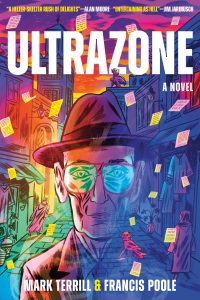 Some months ago Beat Scene featured a novel that came out of the blue, ULTRAZONE. Written by both Mark Terrill and Francis Poole it was set in Tangier in North Africa. Its main character, amongst a host of others, was none other than William Burroughs. There was one big aspect about this William Burroughs, he was dead. This fabulous, thought provoking, fantastic [in the wider sense of the word] novel inhabited a spirit world. Brion Gysin is there also. They often convene in a local cemetery. While respecting the writers the book has a lot of fun in this afterlife. When you think about it, Morocco, Gysin, Burroughs, Paul Bowles and others were open to a ‘spirit world.’ So in that respect this novel, for all its twists and turns, makes a lot of sense. Atmospheres, mystery, intrigue. Creative people like Alan Moore and Jim Jarmusch were enthusiastic about the novel, and they know a few things about other possibilities in books, films, life in general. When Beat Scene featured the book there were many people asking about it, where can they get it and so on? The book was obviously popular and so much so that’s it’s gone into a new edition with fresh cover art. This new edition will be available in the Spring. Contact the publishers by email at https://www.versechorus.com/contact-us
Some months ago Beat Scene featured a novel that came out of the blue, ULTRAZONE. Written by both Mark Terrill and Francis Poole it was set in Tangier in North Africa. Its main character, amongst a host of others, was none other than William Burroughs. There was one big aspect about this William Burroughs, he was dead. This fabulous, thought provoking, fantastic [in the wider sense of the word] novel inhabited a spirit world. Brion Gysin is there also. They often convene in a local cemetery. While respecting the writers the book has a lot of fun in this afterlife. When you think about it, Morocco, Gysin, Burroughs, Paul Bowles and others were open to a ‘spirit world.’ So in that respect this novel, for all its twists and turns, makes a lot of sense. Atmospheres, mystery, intrigue. Creative people like Alan Moore and Jim Jarmusch were enthusiastic about the novel, and they know a few things about other possibilities in books, films, life in general. When Beat Scene featured the book there were many people asking about it, where can they get it and so on? The book was obviously popular and so much so that’s it’s gone into a new edition with fresh cover art. This new edition will be available in the Spring. Contact the publishers by email at https://www.versechorus.com/contact-us
—————————————————————————————————
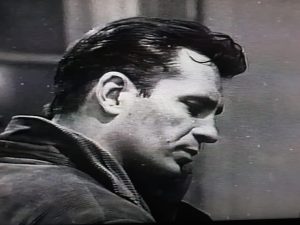 As the 1960s wound down it got increasingly desperate for Jack Kerouac. This photo here, not sure how I got it, made me think of him, sometimes alone at home, alienated from his old friends, like Allen Ginsberg. Self imposed exile some might call it. In Lowell, in Northport, in Florida. The television on a lot. Sometimes with the sound turned down. Jack loved old movies, black and white. Things he had seen as a kid, a young man living in the environs of Greater NYC. By the TV. Was reminded of this by Paul Maher Jr. In a little seen book of his Drunken Dumbshow: Kerouac in the 60s. Jack by that TV. Drinking. Drinking. Drinking. Sometimes invaded by hangers on who lived nearby – often he didn’t really know them, they just came, armed with clinking cans and bottles of alcohol. The ‘Open Sesame’ to Kerouac’s home. There are picture of this. Mostly young kids. Looking for the stupid ‘King of the Beats.’ So sad. This picture though, he seems alert. Side on healthy. Vibrant in a – as he might say – ‘pantheistic way.’ A time where Professor Charles Jarvis, who was a really good, kind, helpful friend to him, while living in Lowell, they would sometimes meet up. Jarvis set up a casual teaching job for Jack at the local High School and it did look like Jack would brave up and go for it, but he ducked out at the last minute. Prof Jarvis wasn’t Neal Cassady, or Allen Ginsberg, or Burroughs, Corso and I’ve a feeling Jack looked upon him as a kindly uncle. He seemed such a good man. He vies with Ann Charters for publishing the very first biography of Jack in 1973. It should be republished in a revamped edition. Fit for our times. [see cover image below]. It wasn’t always Jack being drunk on nationwide tv shows, making a fool of himself. The picture above, wish I knew the exact date it was taken, shows him on a good day maybe.
As the 1960s wound down it got increasingly desperate for Jack Kerouac. This photo here, not sure how I got it, made me think of him, sometimes alone at home, alienated from his old friends, like Allen Ginsberg. Self imposed exile some might call it. In Lowell, in Northport, in Florida. The television on a lot. Sometimes with the sound turned down. Jack loved old movies, black and white. Things he had seen as a kid, a young man living in the environs of Greater NYC. By the TV. Was reminded of this by Paul Maher Jr. In a little seen book of his Drunken Dumbshow: Kerouac in the 60s. Jack by that TV. Drinking. Drinking. Drinking. Sometimes invaded by hangers on who lived nearby – often he didn’t really know them, they just came, armed with clinking cans and bottles of alcohol. The ‘Open Sesame’ to Kerouac’s home. There are picture of this. Mostly young kids. Looking for the stupid ‘King of the Beats.’ So sad. This picture though, he seems alert. Side on healthy. Vibrant in a – as he might say – ‘pantheistic way.’ A time where Professor Charles Jarvis, who was a really good, kind, helpful friend to him, while living in Lowell, they would sometimes meet up. Jarvis set up a casual teaching job for Jack at the local High School and it did look like Jack would brave up and go for it, but he ducked out at the last minute. Prof Jarvis wasn’t Neal Cassady, or Allen Ginsberg, or Burroughs, Corso and I’ve a feeling Jack looked upon him as a kindly uncle. He seemed such a good man. He vies with Ann Charters for publishing the very first biography of Jack in 1973. It should be republished in a revamped edition. Fit for our times. [see cover image below]. It wasn’t always Jack being drunk on nationwide tv shows, making a fool of himself. The picture above, wish I knew the exact date it was taken, shows him on a good day maybe.
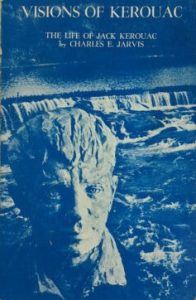
—————————————————————————-
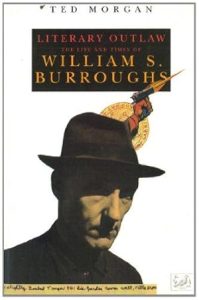 AN IMPROBABLE OUTLAW
AN IMPROBABLE OUTLAW
[as published in CUT magazine March 1989]
Imagine an early twentieth century liner sinking dramatically, while on board in a crude operating room, a half crazed and drugged doctor scoops more drugs into his own bag than he is administering to his dying patient, who slips gently onto the floor. Then, in the blink of an eye, transport yourself to the old American Wild West where no John Wayne ever walked. Take off again to a boardroom of a vast galactic corporation where the board are discussing their latest mutation product. Take three extra spins of the dice and go to the Aztec jungle.
This is the literary world of outlaw William Seward Burroughs, author of such noted and infamous works as Junky and Naked Lunch. It is a world that Ted Morgan has dared to step into. He has compiled the first biography of Burroughs. His book reveals a wild and improbable life. Burroughs’ gentleman’s exterior hides the heart of a real literary renegade. He escaped standing trial for the murder of his own wife. He has lived a crazy life, some of it in [briefly] jail. His homosexuality made him a real outsider in the conventional world of Eisenhower in the Fifties. In short he was homosexual when it was a criminal offence.
His close friends have included Jack Kerouac, Allen Ginsberg, Timothy Leary, Mick Jagger and Jean Genet. His life is really the story of the counterculture in America and Europe. The biography is a welcome addition to our knowledge of this man and his times. you may at times admire him, at times loathe him, but you cannot ignore him. Fast approaching 80, Burroughs is now more marshall than an outlaw. The book, with its 704 pages and 24 pages of black and white photos is a timely publication.
Kevin Ring
Literary Outlaw: The Life and Times of William S. Burroughs by Ted Morgan, published by Henry Holt as a hardback at $24.95
Reviewed in Cut Magazine Vol 4, No 2. March 1989. In Edinburgh, Scotland.
———————————————————————————–
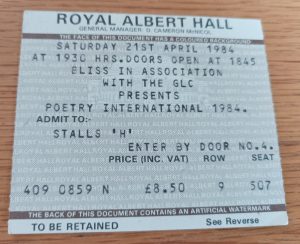
Rummaging in boxes in search of something that was never found, an item did reveal itself. This ticket you see here pictured. Was sort of a half shock to realise it was over 40 years ago. The event, my memory tells me it might have been, at least partially, organised by Goldmark Books in Uppingham in Rutland. They had, may still have, a terrific bookshop. It was a place we used to venture to back then, there were at least two other used bookstores in adjoining streets in this tiny little backwater of a town. Quintessentially ‘Old England’ it struck me as. Of course they have the Public School there. Once went to an Iain Sinclair reading there. Iain has had strong connections with Goldmark. They have published one or two of his books over the years. Quite how that connection happened is a mystery to me. But, regardless of all that, this Saturday, April 21, 1984 poetry reading at London’s Albert Hall, captured the imagination of many Beat enthusiasts. Some ‘Beat Generation’ poets were going to be there, along with a number of other British and European poets. One of whom, the late Benjamin Zephaniah, was so impressive. Another time I went to see him read in a Coventry School. I was a school teacher myself back then. He read to maybe 30 people as we sat on school chairs in a classroom. But he read as though there were 3,000 of us. Animated, dynamic, impassioned, and with that big smile of his. It was a time of black poets emerging, talking back at the entrenched racism of British society. Linton Kwesi Johnson was another. Allen Ginsberg was there, Lawrence Ferlinghetti and possibly others. Perhaps you were and can fill in the gaps. It was a busy day getting there. Being the dad of a four year old son he had to be transported to his loving grandmother for the day. Another Beat enthusiast Bill Lamdin from Stoke on Trent got collected from the station and he, along with another local friend, Gary and M.Ring we picked up two more chaps from 20 miles away and made our way down to London. Meeting up with another Beat aficionado Tony Floyd in Compendium books. Buying a couple of books from Nick Kimberly there. I’m guessing Nick was back there after his Duck Soup bookshop venture? People had travelled far and wide. There must have been about thirty or forty of us meeting in the park across the road from the Albert Hall. David Joyce [the very first person I sold a book to as ‘Satori Books’] had travelled all the way from Lancaster in Cumberland and so on. Remember, no internet, most didn’t have a house phone. It was sometimes wonderful like that. It would be a lie to say the show was a sell out. My diary tells me it wasn’t. However there were a lot of people there. Maybe the organisers were hoping for a recreation of the 1965 Albert Hall get together. The Wholly Communion thing. All these people that had travelled to get there, I sensed they were heartened to realise there were others like them. Just as it was back in 1965. We piled out of the reading and recall a big group of us spent the evening in a bar near the Thames. It was, thankfully, a mellow Spring evening. We got home just before 5 a.m.
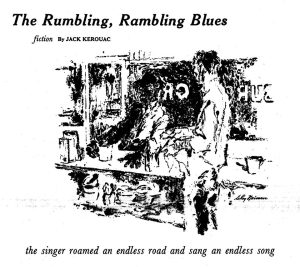
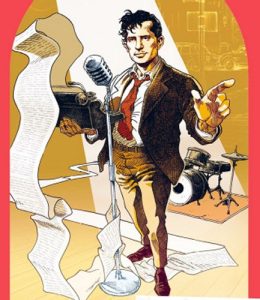 Caricature of Jack Kerouac. This one gets very near the mark. No idea who created it. Guessing they based it on his near disaster of a week reading at a club in NYC. Where Steve Allen kindly helped him out. Don’t think Jack ever dared to do another live performance.
Caricature of Jack Kerouac. This one gets very near the mark. No idea who created it. Guessing they based it on his near disaster of a week reading at a club in NYC. Where Steve Allen kindly helped him out. Don’t think Jack ever dared to do another live performance.
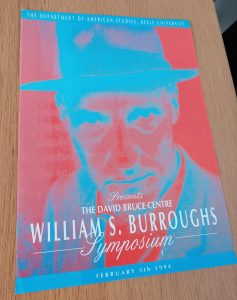
Thirty years ago. A William Burroughs ‘Symposium’ was held at Keele University in England, hosted by their American Studies department. A one day event. February 5, 1994. Speakers included David Ayers – with a talk ‘William Burroughs and the Law of Poetic Meaning.’ Jim Burns ‘William Burroughs: Hip, Not Beat.’ Oliver Harris – ‘As Ever: William Burroughs, Man of Letters.’ Ian MacFadyen with ‘Korzybskian Semantics, Polemics, and the Science in the works of William Burroughs.’ Eric Mottram, “The Self-Sustaining Oasis: William Burroughs Since 1975.”
Beat Scene No. 110 (Spring 2024)
Coventry, England, UK: Beat Scene Press, 2024. First Printing. Perfect Bound. This latest (as of this writing) number of the magazine-format literary journal devoted to the Beat Generation edited, published & with contributions by Kevin Ring in the UK, features articles including that concerning the canonical American-expatriate author & composer Paul Bowles by Ring; on cult favorite Charles Bukowski by Jack Grapes; a 1963 interview with William S. Burroughs conducted by W.J. Weatherby; a memorial tribute to Baby Beat/ Second San Francisco Renaissance Giant- & our beloved friend- Neeli Cherkovski (1945-2024) by Ring; on Gregory Corso’s meeting with Bukowski in New Mexico during 1970 by Kurt Hemmer (our esteemed colleague at the European Beat Studies Network, ebsn.eu); on Allen Ginsberg by Patrick Fenton; on a stranger-than-fiction early true-life adventure of Brion Gysin by Gregory Stephenson (another of our distinguished EBSN colleagues); on Herbert Huncke by Kit Knight; on Jack Kerouac by Reggie Hands; on Gertrude Stein by Tim Hather; on Fugs-cult legend Tuli Kupferberg by Lee A. Scharf; & yet much more. With, as ever, a robust review section including a droll & penetrating piece on James Grauerholz’ “The Death of Joan Vollmer Burroughs: What Really Happened?” by Jim Pennington (yet another of our honored EBSN colleagues & a key figure of Burroughsian Secret Fascination); many vintage images throughout; etc. Rich in insight & variety, chock-full of newly-revealed anecdotes & connections from the seemingly bottomless Beat well, here is another great issue in the indispensable series that always more-than-lives-up to its stirring front cover motto: “This is the Beat Generation.” This writer always collects & devours every issue cover-to-cover, & most-highly recommends that all Third Minds emulate accordingly. See our many other issues of Beat Scene magazine & special BSP productions. In very fine condition, essentially as-new with only a touch of rubbing, faint scratching to front, back covers & spine; a few tiny bumps, creases at edges & corners of same. Interior very fine with only tiny bumps, faint creases at upper corners of page leaves. Very Fine. [Item #6636]
—————————————————————–

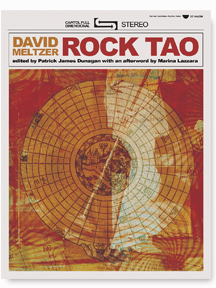
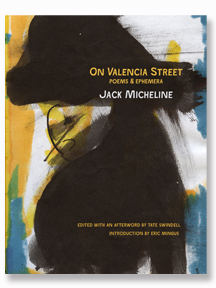 Looking for something, isn’t it always the case, and finding something else, this lovely bookmark fell out of a copy of ROCK TAO by the late poet David Meltzer. [see also his fabulous BEAT THING]. He was a longstanding figure on the San Francisco literary scene, as poet, musician, anthologist, critic. ROCK TAO is a brilliant speed run through many of Meltzer’s cultural obsessions. Published by Lithic Press, who also did a terrific, imaginative and quite lavish book on Jack Micheline. ON OLD VALENCIA STREET. They are a publisher you should watch. After reflecting for a sad minute on the passing of the old poetry guard, it struck me how they resonate still and probably will far into the future. They may dim a little at points, be rediscovered again for a while, go away, come back. It is the nature of things isn’t it. And then there is this little bookmark. Don’t know anything about Jack Mueller I confess, other than his name as a poet is logged in my memory banks. But San Francisco’s Beat Museum see fit to stage a poetry reading of his. It was a while back and he must fit into the Beat family tree somewhere along the way, to get his gig at Jerry Cimino’s fine establishment. It seems to be a living, breathing, organic, evolving place. Devoted to this nebulous idea of a Beat Generation. What’s in a name, anyway.
Looking for something, isn’t it always the case, and finding something else, this lovely bookmark fell out of a copy of ROCK TAO by the late poet David Meltzer. [see also his fabulous BEAT THING]. He was a longstanding figure on the San Francisco literary scene, as poet, musician, anthologist, critic. ROCK TAO is a brilliant speed run through many of Meltzer’s cultural obsessions. Published by Lithic Press, who also did a terrific, imaginative and quite lavish book on Jack Micheline. ON OLD VALENCIA STREET. They are a publisher you should watch. After reflecting for a sad minute on the passing of the old poetry guard, it struck me how they resonate still and probably will far into the future. They may dim a little at points, be rediscovered again for a while, go away, come back. It is the nature of things isn’t it. And then there is this little bookmark. Don’t know anything about Jack Mueller I confess, other than his name as a poet is logged in my memory banks. But San Francisco’s Beat Museum see fit to stage a poetry reading of his. It was a while back and he must fit into the Beat family tree somewhere along the way, to get his gig at Jerry Cimino’s fine establishment. It seems to be a living, breathing, organic, evolving place. Devoted to this nebulous idea of a Beat Generation. What’s in a name, anyway.
——————————————————————————————-

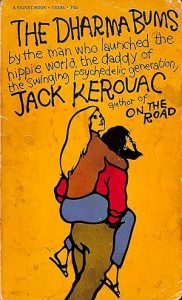 While searching for old information in a diary I came across an entry for February 25, 1980. the owner of Walden Books in Camden Town/Chalk Farm had phoned me up – David Tobin. Wanted to know if I’d be keen on two old copies of Jack Kerouac’s The Dharma Bums and also The Subterraneans? This is what – 44 years ago. David was asking for 50p each for these lovely old editions. Looking back it seems almost impossible. I’d been to David’s bookshop – it was tucked away in a Camden/Chalk Farm backstreet, closer to the famous Roundhouse, where The Dialectics of Liberation event had taken place, memorialised by Iain Sinclair in his The Kodak Mantra Diaries back in the early 1970s. And not far from Marine Ices. R.D. Laing and all that. A brisk, longish walk from Compendium Books on Camden High Street. I’d spoken to David in his shop, it seemed a place sympathetic to the Beats and associated people. A used bookstore. Sort of an Aladdin’s Cave to someone like I was back then. Keen, eager, a bit green. Yes, of course 50p each. Thank you David. They were posted and arrived a couple of days later. My cheque went off in the post. Seem to recall paper catalogues from Walden Books as well. I still have those two paperbacks here on my Kerouac oldies shelf. And Walden Books and David Tobin are still there, all these years later. You have to admire that, a calm resilience in the face of digitalisation of the planet, virtual everything. Looking at this 1980 diary I’m reminded that I was a fairly regular visitor to the store. Always walking up after going in the much missed Compendium Books. And regular packages were sent in the mail from David Tobin. Not long after Carolyn Cassady moved in just up the road in Belsize Park. Went to see her there a couple of times, she had a little table, she might have jokingly said it was a kind of shrine to Jack and Neal. Photos and the like. It all seemed to have a connectedness about it. www.waldenbooks.co.uk
While searching for old information in a diary I came across an entry for February 25, 1980. the owner of Walden Books in Camden Town/Chalk Farm had phoned me up – David Tobin. Wanted to know if I’d be keen on two old copies of Jack Kerouac’s The Dharma Bums and also The Subterraneans? This is what – 44 years ago. David was asking for 50p each for these lovely old editions. Looking back it seems almost impossible. I’d been to David’s bookshop – it was tucked away in a Camden/Chalk Farm backstreet, closer to the famous Roundhouse, where The Dialectics of Liberation event had taken place, memorialised by Iain Sinclair in his The Kodak Mantra Diaries back in the early 1970s. And not far from Marine Ices. R.D. Laing and all that. A brisk, longish walk from Compendium Books on Camden High Street. I’d spoken to David in his shop, it seemed a place sympathetic to the Beats and associated people. A used bookstore. Sort of an Aladdin’s Cave to someone like I was back then. Keen, eager, a bit green. Yes, of course 50p each. Thank you David. They were posted and arrived a couple of days later. My cheque went off in the post. Seem to recall paper catalogues from Walden Books as well. I still have those two paperbacks here on my Kerouac oldies shelf. And Walden Books and David Tobin are still there, all these years later. You have to admire that, a calm resilience in the face of digitalisation of the planet, virtual everything. Looking at this 1980 diary I’m reminded that I was a fairly regular visitor to the store. Always walking up after going in the much missed Compendium Books. And regular packages were sent in the mail from David Tobin. Not long after Carolyn Cassady moved in just up the road in Belsize Park. Went to see her there a couple of times, she had a little table, she might have jokingly said it was a kind of shrine to Jack and Neal. Photos and the like. It all seemed to have a connectedness about it. www.waldenbooks.co.uk
————————————————————————————
So often in Beat Scene the ‘enablers’ around the Beat Generation, the publishers and such like, come in for high praise. You know the names. Moody Street Irregulars, The Kerouac Connection, John Montgomery’s Fels & Fern Press [and his brilliant relentless letter writing], Arthur and Kit Knight [not forgetting Glee Knight], Soft Need and the Burroughs connection, Jim Burns with both Move and Palantir. There are others. It’s a backwards look. So, it is refreshing to report on the new continuing work of Jean Francois Duval in Switzerland. For a long time now Jean has been writing up, anthologising and editing the Beat Generation, alongside another favourite of his, Charles Bukowski. A new pocket book, lovingly, stylishly presented is his LES 100 MOTS DE LA BEAT GENERATION. [Que Sais-Je?] entirely in French, so it will largely be of interest to Francophiles in its present state. I understand there are plans for an English language edition. For the ‘completists’ among you, the ISBN is 978-2-7154-2180-6. www.quesaisje.com
And thank you Jean for saying – ”
"The British quarterly magazine Beat Scene, created in 1988 by Kevin Ring,
remains the exchange platform for all those interested in the Beat movement
in all its diversity of expressions."
Yep, I'll take that Jean, merci.
———————————————————————————————-
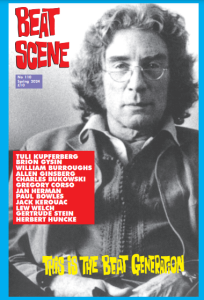 BEAT SCENE No 110 is out NOW. A technical hitch held it up. My own stupid fault. We, me and my trusty assistant, The Lone Ranger and Tonto, or Abbott and Costello, if you prefer, are mailing them out as quickly as we can. We WILL get to you, rest assured. Patience is the key. You’ll find the following inside – Tuli Kupferberg, Brion Gysin, Gregory Corso, Paul Bowles, Herbert Huncke, William Burroughs, Lew Welch, Charles Bukowski, Allen Ginsberg, Jan Herman, Gertrude Stein and Jack Kerouac. [or ‘Carrawack’ as Kenneth Rexroth called him]. Anyone interested in buying a copy please email me at kevbeatscene@gmail.com
BEAT SCENE No 110 is out NOW. A technical hitch held it up. My own stupid fault. We, me and my trusty assistant, The Lone Ranger and Tonto, or Abbott and Costello, if you prefer, are mailing them out as quickly as we can. We WILL get to you, rest assured. Patience is the key. You’ll find the following inside – Tuli Kupferberg, Brion Gysin, Gregory Corso, Paul Bowles, Herbert Huncke, William Burroughs, Lew Welch, Charles Bukowski, Allen Ginsberg, Jan Herman, Gertrude Stein and Jack Kerouac. [or ‘Carrawack’ as Kenneth Rexroth called him]. Anyone interested in buying a copy please email me at kevbeatscene@gmail.com
And, I might add, Beat Scene 111 won’t be far behind. As it says, ‘This is definitely the Beat Generation.’
—————————————————————————–
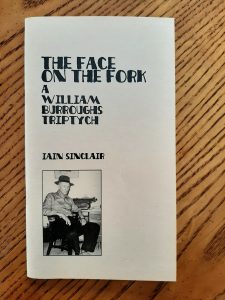
Had a few people asking for a copy of this chapbook lately. THE FACE ON THE FORK: A WILLIAM BURROUGHS TRIPTYCH by Iain Sinclair. It was issued in 2012 in an edition of 125 numbered and signed copies. It went very quickly. There are no plans to produce any more right now. Only so many hours in the day. But who knows in the future. It made me smile, but feel dismayed when I saw a copy of it selling for close on £100 on the net not so long ago. Nothing to do with me. Copies went for around £8 twelve years ago. Pleased to have done it in collaboration with Iain.
———————————————————————
This little chap is what they call a ‘Bobblehead Jack Kerouac. Until very recently I’d never seen one in the flesh, so to speak. They began to surface about 15 years ago in America. This one recalls the Kerouac American football heyday. Do they call it ‘gridiron?’ It seems to be the big sport in the USA. Not sure why. A lot of the players don’t seem to ever touch the ball. Weird. There are other Jack Kerouac ‘bobbleheads’. Maybe three or four different ages and poses. Hard to imagine what Jack, who, as the story goes, was down to his last $91 dollars at the time of his death in 1969, aged 47, would have thought about it. He might have been appalled at the gross commercialism of his name. No, strike that, he would have laughed and then been appalled more likely. But each to their own. Some people really like these figures. I’m holding it now, it is fairly heavy and the head does ‘bobble.’ Give me a book anytime.
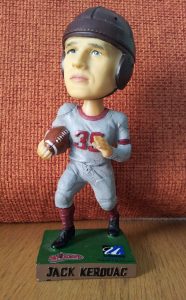
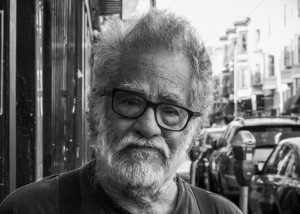 Sad news that Neeli Cherkovski has just died. He was 78. Heart problems. Neeli was a mainstay in the San Francisco poetry landscape for decades. Sad because I only had a note from him a few weeks ago. He was hoping I’d include his forthcoming poetry collection in Beat Scene. Like I often say, is the Pope a Catholic? Of course I wanted to include it and can we do an interview too Neeli? You may know Neeli through his poetry, or maybe you read his book WHITMAN’S WILD CHILDREN, or the biographies he wrote of both Lawrence Ferlinghetti and Charles Bukowski, or the string of small press poetry books over the years. He should still be here. I never met him, but once talking for a short while with Jack Hirschman we talked about him. People should talk about him. He was well loved. More in the next issue of Beat Scene.
Sad news that Neeli Cherkovski has just died. He was 78. Heart problems. Neeli was a mainstay in the San Francisco poetry landscape for decades. Sad because I only had a note from him a few weeks ago. He was hoping I’d include his forthcoming poetry collection in Beat Scene. Like I often say, is the Pope a Catholic? Of course I wanted to include it and can we do an interview too Neeli? You may know Neeli through his poetry, or maybe you read his book WHITMAN’S WILD CHILDREN, or the biographies he wrote of both Lawrence Ferlinghetti and Charles Bukowski, or the string of small press poetry books over the years. He should still be here. I never met him, but once talking for a short while with Jack Hirschman we talked about him. People should talk about him. He was well loved. More in the next issue of Beat Scene.
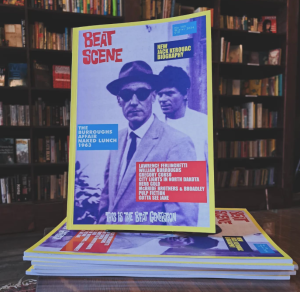 A heartening photo from Dave Pedersen owner of the Maze Books store. The new Beat Scene on display in the shop. Thanks for your order Dave. Maze is a general used bookstore I understand. They have a fondness for the Beat Generation writers and all those connected with them. If it is within a reasonable distance of you it sounds like a place to visit – if you like old fangled things like books. They are at 406 E. State Street, Rockford, Illinois 61104, USA. Email is mazebooks@gmail.com and the site is https://www.maze-books.com/
A heartening photo from Dave Pedersen owner of the Maze Books store. The new Beat Scene on display in the shop. Thanks for your order Dave. Maze is a general used bookstore I understand. They have a fondness for the Beat Generation writers and all those connected with them. If it is within a reasonable distance of you it sounds like a place to visit – if you like old fangled things like books. They are at 406 E. State Street, Rockford, Illinois 61104, USA. Email is mazebooks@gmail.com and the site is https://www.maze-books.com/
—————————————————————————————
Opening up this page you will see a very early issue of Beat Scene number 14. Sporting a posed picture of William Burroughs and film director David Cronenberg – during the making of NAKED LUNCH. It was a daring film, it must have been a dickens of a task getting it onto the big screen. Even if I say it myself, blowing my own trumpet, it is a decent go at things for a totally independent, no sponsorship, no university affiliation, no advertising magazine, focused totally on a specific area of interest. Richard Brautigan, The Shadow, Jim Carroll, Charles Bukowski, Charles Plymell, Philip Whalen, William Burroughs, Jack Kerouac, Hunter S. Thompson and John Giorno (love his I DON’T WANT IT, I DON’T NEED IT AND YOU CHEATED ME OUT OF IT) it never fails for me, an extension of Gysin and Burroughs and their recordings for sure. Of course all issues of this edition from the very early 1990s are long gone. Back then so many of the Beats and all those often linked and associated with them, were still here, Allen Ginsberg, Burroughs of course, Charles Bukowski, so many gone in these intervening years. But rest assured Beat Scene will continue to delve into their lives and work.
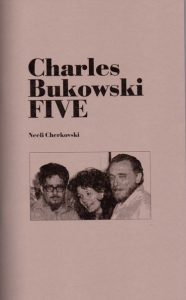 Found in a box this morning. It often happens, looking for something else I discover a missing item. Ten years ago, blooming eck, CHARLES BUKOWSKI FIVE by Neeli Cherkovski was number 45 in the Beat Scene Press chapbook series. 125 numbered copies. An excerpt from Neeli’s biography of Charles Bukowski HANK. Neeli was a good friend of Bukowski. They are photographed together on the front cover with the first Linda. The other Linda that Bukowski had an often stormy relationship with. Neeli remains to this day a well respected writer, poet in San Francisco. He published a one off literary magazine with Bukowski way back. They were both hopeless at it and it was short lived. Neeli also wrote WHITMAN’S WILD CHILDREN, a book that should really be reprinted, including as it does sections on 11 poets – John Wieners, Ferlinghetti, Bob Kaufman, Philip Lamantia, William Everson, James Broughton, Ginsberg, Corso, Harold Norse and Charles Bukowski. It first appeared in 1988. Neeli has also written further on Bob Kaufman and penned a biography of the late Lawrence Ferlinghetti. Add to that a string of poetry books, right up until now. If you are interested in CHARLES BUKOWSKI: FIVE – get in touch at kevbeatscene@gmail.com
Found in a box this morning. It often happens, looking for something else I discover a missing item. Ten years ago, blooming eck, CHARLES BUKOWSKI FIVE by Neeli Cherkovski was number 45 in the Beat Scene Press chapbook series. 125 numbered copies. An excerpt from Neeli’s biography of Charles Bukowski HANK. Neeli was a good friend of Bukowski. They are photographed together on the front cover with the first Linda. The other Linda that Bukowski had an often stormy relationship with. Neeli remains to this day a well respected writer, poet in San Francisco. He published a one off literary magazine with Bukowski way back. They were both hopeless at it and it was short lived. Neeli also wrote WHITMAN’S WILD CHILDREN, a book that should really be reprinted, including as it does sections on 11 poets – John Wieners, Ferlinghetti, Bob Kaufman, Philip Lamantia, William Everson, James Broughton, Ginsberg, Corso, Harold Norse and Charles Bukowski. It first appeared in 1988. Neeli has also written further on Bob Kaufman and penned a biography of the late Lawrence Ferlinghetti. Add to that a string of poetry books, right up until now. If you are interested in CHARLES BUKOWSKI: FIVE – get in touch at kevbeatscene@gmail.com
———————————————————————————————-
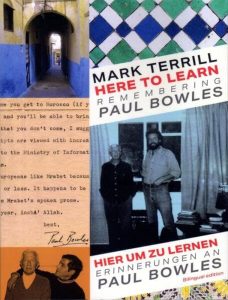 Neat little pocket book from Mark Terrill just came in the post today. HERE TO LEARN: REMEMBERING PAUL BOWLES. Published by the excellent Moloko Press. Mark has recalled his time with Paul Bowles in North Africa, gradually discovering what made him tick. First as a student on a writing course, later as good friends. Seeing how Bowles helped people with their writing. A quiet, unobtrusive way about him. We learn a little more about the filming of the Bowles novel THE SHELTERING SKY. Also, about his life in Tangier, the daily line of visitors, some not always that welcome, a few freeloaders, armed with secret tape machines. It’s a close up look at this mostly private, sometimes almost hermetic writer. You might already know of Mark Terrill – along with Francis Poole he co authored that terrific book ULTRAZONE, which impressed me so much, dealing as it does with William Burroughs in an afterlife. The book is attractively laid out, which is typical of Moloko books, they have a keen eye for detail. https://www.sea-urchin.net/books/moloko-books/
Neat little pocket book from Mark Terrill just came in the post today. HERE TO LEARN: REMEMBERING PAUL BOWLES. Published by the excellent Moloko Press. Mark has recalled his time with Paul Bowles in North Africa, gradually discovering what made him tick. First as a student on a writing course, later as good friends. Seeing how Bowles helped people with their writing. A quiet, unobtrusive way about him. We learn a little more about the filming of the Bowles novel THE SHELTERING SKY. Also, about his life in Tangier, the daily line of visitors, some not always that welcome, a few freeloaders, armed with secret tape machines. It’s a close up look at this mostly private, sometimes almost hermetic writer. You might already know of Mark Terrill – along with Francis Poole he co authored that terrific book ULTRAZONE, which impressed me so much, dealing as it does with William Burroughs in an afterlife. The book is attractively laid out, which is typical of Moloko books, they have a keen eye for detail. https://www.sea-urchin.net/books/moloko-books/
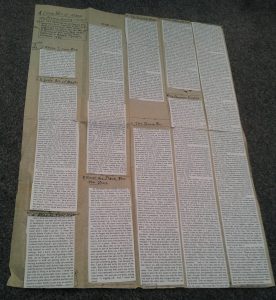

Dipping into boxes of late and things not seen for a decade or so are turning up. Not exactly forgotten but tucked away in the distant boxes of the memory bank. Ah, yes, moments if you like. Onesuch was a package from the late American poet Tom Clark who died while crossing the road near his Berkeley home in the small hours. Like Charles Dickens he was a night walker. Iain Sinclair reminded me that Tom had been hit at the same spot a few years earlier but escaped and recovered. This time he was not so lucky. In the packet was a fold out, home made affair that Tom had done especially for me. The packet is dated May 17, 2004, so fast approaching twenty years ago. As you can see from the image here Tom had cut up a copy of an interview that he and poet Ted Berrigan had conducted with Ken Kesey in July 1978 in Boulder, Colorado. The interview appeared in The Boulder Monthly in November 1978, Tom notes this in his neat handwriting at top left of the image. It wasn’t the first time Tom had collaborated on a major interview with Ted Berrigan. As you’ll no doubt recall Ted Berrigan was involved in the Paris Review interview with Jack Kerouac in 1968, an interview widely considered in Kerouac circles to be perhaps the best Kerouac interview, Tom set that up and was supposed to travel with Ted Berrigan and Aram Saroyan to Kerouac’s home. They called in at Tom’s on the way to Jack’s but for some reason never made clear Tom didn’t go. I’d love to know why. Of course when Tom took over the poetry editor job at the Paris Review he opened the doors to all the poets of the new wave. The NY School Poets, Black Mountain, Beats, you name it. A major reason why copies of the Paris Review from those years are so well thought of. William Burroughs and Gary Snyder in The Paris Review, heavens above, whatever next, the old guard probably exclaimed. But here Tom has cut out and arranged the interview with Ken Kesey, adding his notes to pinpoint key areas. Tom always had firm thoughts and opinions, in our correspondence he wasn’t slow to express himself. He was a big baseball fan and, surprisingly, a football fan. He knew so much about English football and, reassuringly, he called it football, not soccer. He didn’t seem to sleep much at night and let me know which games he had watched on TV, from Liverpool, to Montivideo. It is a lively interview with Ken Kesey, a man Beat Scene has interviewed in its lifetime. Ken ranges from Moby Dick to Sesame Street, from his early unpublished novel to Arthur Miller. I wonder if it has ever been published since? More research required. Tom also included a faux baseball card and his photo is on it, he signed it. You’ll see the card here somewhere here as well. A nice touch. We corresponded for a good few years. One of the earliest Beat Scene chapbooks was one of Tom’s letters from his time at Cambridge University. Loved doing that, reading and discovering things about this fellow and his life in lodgings in England in the very early 1960s, writing home for books. This fold out, hand made construction was such a kind thought on his part.
—————————————————————————
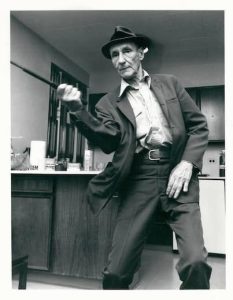 I’ve started mailing out the very latest chapbook – OUT NOW from the Beat Scene Press – THE BURROUGHS FLYER by James Birmingham. Number 80 in this long running series. In the regular format. One hundred and twenty five numbered copies. If you would like a copy do let me know. Email kevbeatscene@gmail.com
I’ve started mailing out the very latest chapbook – OUT NOW from the Beat Scene Press – THE BURROUGHS FLYER by James Birmingham. Number 80 in this long running series. In the regular format. One hundred and twenty five numbered copies. If you would like a copy do let me know. Email kevbeatscene@gmail.com
******* Further to this latest Beat Scene chapbook THE BURROUGHS FLYER by James Birmingham – English writer Iain Sinclair has read it and got in touch about James talking about the late, well admired English bookdealer Martin Stone (also a rock musician with bands like Mighty Baby, Savoy Brown) and how it would have been something for Martin to have fronted a book search show on TV. Here’s what Iain Sinclair told me a day or two ago (and Iain is no stranger to book selling in his formative years) – “…a PS after reading James Birmingham’s nifty piece. He says that he’d like to see a TV show ‘following Martin Stone’ as he searches for rare books. You could tell him that the pilot already exists & is out there on the internet. It’s called ‘The Cardinal & the Corpse’. A pretty accurate portrait of that period in the used-book trade & some of the collected authors. My one claim to future fame in this mythology is that I introduced Peter Howard to Martin, driving him down to Cannon Street Road & the house that features in ‘White Chappell, Scarlet Tracings’. Instant connection between those 2 obsessive bibliophiles.”
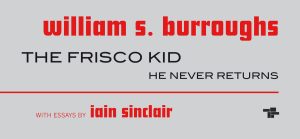 And, WATCH OUT for WILLIAM S. BURROUGHS THE FRISCO KID – HE NEVER RETURNS with essays by Iain Sinclair coming out, possibly December, through Michael Curran’s Tangerine Press in London.
And, WATCH OUT for WILLIAM S. BURROUGHS THE FRISCO KID – HE NEVER RETURNS with essays by Iain Sinclair coming out, possibly December, through Michael Curran’s Tangerine Press in London.
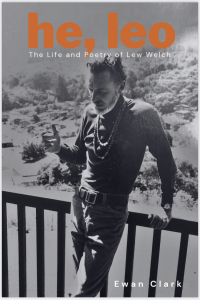 A book that has been such a long time coming is HE, LEO – The Life and Poetry of Lew Welch by Ewan Clark. Published by Oregon State University Press. A substantial paperback it aims to fill in so many gaps. The time Welch spent at Reed College up on America’s Northwest Coast is one area where Ewan Clark makes great progress, devoting time to figures like a teacher at the college, Lloyd Reynolds, who seems to have had a profound impact, not only on Welch, but his famed companions in poetry, Gary Snyder and Philip Whalen. Ewan Clark goes into the troubled family life of Welch, his absent father, his driven mother, where, as I read it, she devoted more time to her own academic life – leaving an emotional emptiness in Lew’s life that would stay with him. It’s not the place to give away too much of the story that Ewan Clark brings to us, obviously most Beat readers will want to tune in to the life of the poet Lew Welch and there is plenty there. Welch was a late starter. He might have been a reader at that famed Six Gallery reading in 1955, instead he was trying to nail down a kind of ‘straight life’ in the Chicago advertising world, a married man, on his way to a home in the suburbs. All that was finally problematic for him. Ever since the early 1970s, when he went missing with his rifle, presumed dead, that mysterious ending has overshadowed his poetic life. Ewan Clark’s new biography finally gets to grips with the man and a clearer, bigger, fuller, picture emerges.
A book that has been such a long time coming is HE, LEO – The Life and Poetry of Lew Welch by Ewan Clark. Published by Oregon State University Press. A substantial paperback it aims to fill in so many gaps. The time Welch spent at Reed College up on America’s Northwest Coast is one area where Ewan Clark makes great progress, devoting time to figures like a teacher at the college, Lloyd Reynolds, who seems to have had a profound impact, not only on Welch, but his famed companions in poetry, Gary Snyder and Philip Whalen. Ewan Clark goes into the troubled family life of Welch, his absent father, his driven mother, where, as I read it, she devoted more time to her own academic life – leaving an emotional emptiness in Lew’s life that would stay with him. It’s not the place to give away too much of the story that Ewan Clark brings to us, obviously most Beat readers will want to tune in to the life of the poet Lew Welch and there is plenty there. Welch was a late starter. He might have been a reader at that famed Six Gallery reading in 1955, instead he was trying to nail down a kind of ‘straight life’ in the Chicago advertising world, a married man, on his way to a home in the suburbs. All that was finally problematic for him. Ever since the early 1970s, when he went missing with his rifle, presumed dead, that mysterious ending has overshadowed his poetic life. Ewan Clark’s new biography finally gets to grips with the man and a clearer, bigger, fuller, picture emerges.
————————————————————————————————————————-
 Thank you to Tim Hather up in Scotland for letting me know about this BBC Radio 3 half hour show about the artist Joe Brainard. As you may know Joe Brainard was sort of the unofficial ‘official’ artist and designer for so many little press publications produced by poets like Anne Waldman, Lewis Warsh, Ted Berrigan, Frank O’Hara, Tom Clark and so many others. He, along with Philip Guston for a time, seemed to be involved with so many important independent little magazines – the likes of whom can be found in detail in books like the indispensable A Secret Location on the Lower East Side: Adventures in Writing 1960-1980 – by Steven Clay & Rodney Phillips – published by Granary Books and the equally laudable All Poets Welcome: The Lower East Side Poetry Scene in the 1960s by Daniel Kane – published by The University of California Press. The main drift of this BBC Radio 3 show is the much loved Joe Brainard book I Remember – where the artist recalls the details of his life in his own inimitable way – new lines always commencing with – I remember…Anne Waldman and Eileen Myles recall him, old friends. Anyone who has an interest in the New York City poetry scene of the 1960s and the next twenty years might enjoy this show. Some of the show’s participants recall an ultra conservative, draconian, repressive and even dangerous America. Brainard seemed to rise above all that. Go to https://www.bbc.co.uk/sounds/play/m001qvsj
Thank you to Tim Hather up in Scotland for letting me know about this BBC Radio 3 half hour show about the artist Joe Brainard. As you may know Joe Brainard was sort of the unofficial ‘official’ artist and designer for so many little press publications produced by poets like Anne Waldman, Lewis Warsh, Ted Berrigan, Frank O’Hara, Tom Clark and so many others. He, along with Philip Guston for a time, seemed to be involved with so many important independent little magazines – the likes of whom can be found in detail in books like the indispensable A Secret Location on the Lower East Side: Adventures in Writing 1960-1980 – by Steven Clay & Rodney Phillips – published by Granary Books and the equally laudable All Poets Welcome: The Lower East Side Poetry Scene in the 1960s by Daniel Kane – published by The University of California Press. The main drift of this BBC Radio 3 show is the much loved Joe Brainard book I Remember – where the artist recalls the details of his life in his own inimitable way – new lines always commencing with – I remember…Anne Waldman and Eileen Myles recall him, old friends. Anyone who has an interest in the New York City poetry scene of the 1960s and the next twenty years might enjoy this show. Some of the show’s participants recall an ultra conservative, draconian, repressive and even dangerous America. Brainard seemed to rise above all that. Go to https://www.bbc.co.uk/sounds/play/m001qvsj
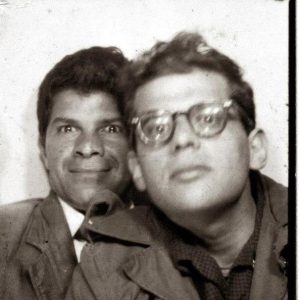 Thanks to Beat Scene reader Colin McCluskey for pointing me towards a feature in today’s THE GUARDIAN, an English daily newspaper – Wednesday August 30. Allen Ginsberg’s photos, a handful of them. You have probably seen them all before, yet it is pleasing to see Allen Ginsberg get a little focus in the mainstream. He captured his images largely in black and white. Here’s one, not in the exhibit, in colour with Gregory Corso on a New York City street. Go to https://www.theguardian.com/books/gallery/2023/aug/30/beats-connection-allen-ginsberg-inner-circle-in-pictures
Thanks to Beat Scene reader Colin McCluskey for pointing me towards a feature in today’s THE GUARDIAN, an English daily newspaper – Wednesday August 30. Allen Ginsberg’s photos, a handful of them. You have probably seen them all before, yet it is pleasing to see Allen Ginsberg get a little focus in the mainstream. He captured his images largely in black and white. Here’s one, not in the exhibit, in colour with Gregory Corso on a New York City street. Go to https://www.theguardian.com/books/gallery/2023/aug/30/beats-connection-allen-ginsberg-inner-circle-in-pictures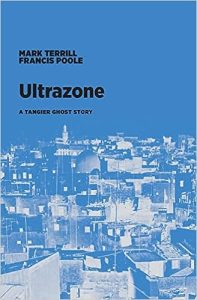 The first 80 pages of ULTRAZONE: A Tangier Ghost Story by Mark Terrill and Francis Poole have flown by. If you haven’t already picked up on this 350 page novel about William Burroughs and a whole cast of characters in the twilight zone of Interzone as Burroughs and company strive to stave off the Ugly Spirit and other demons as they drift about Tangier, do so. It is equally a serious book, the writers tapping into that particular world of beliefs in spirits, devils, curses, witchcraft that is so unlike the West – equally it is funny in a light touch way. Ghosts gather in well tended cemeteries, discuss their plans of action. And, yes, there are Mugwumps. Gysin, Bowles and others, who I’ve yet to encounter in the book, apparently enter the scene. This life after death opens up so many possibilities. We return to the unfolding days of an as yet unpublished Naked Lunch. The book has taken me by surprise and it’s a delight to read. Beat Scene will, all being well, publish an interview with the co writers. Shades of Kerouac and Burroughs teaming up.
The first 80 pages of ULTRAZONE: A Tangier Ghost Story by Mark Terrill and Francis Poole have flown by. If you haven’t already picked up on this 350 page novel about William Burroughs and a whole cast of characters in the twilight zone of Interzone as Burroughs and company strive to stave off the Ugly Spirit and other demons as they drift about Tangier, do so. It is equally a serious book, the writers tapping into that particular world of beliefs in spirits, devils, curses, witchcraft that is so unlike the West – equally it is funny in a light touch way. Ghosts gather in well tended cemeteries, discuss their plans of action. And, yes, there are Mugwumps. Gysin, Bowles and others, who I’ve yet to encounter in the book, apparently enter the scene. This life after death opens up so many possibilities. We return to the unfolding days of an as yet unpublished Naked Lunch. The book has taken me by surprise and it’s a delight to read. Beat Scene will, all being well, publish an interview with the co writers. Shades of Kerouac and Burroughs teaming up.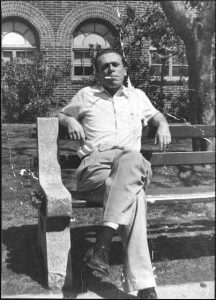
————————————————————————————————————
 This is Neal Cassady. He’s in his last years. Don’t know who took the picture. Neal is certainly having a bright clothes day and look at those red shoes. Would imagine the angels would want to wear his red shoes. With apologies to Mr. Costello. There’s Albert Einstein, a Grateful Dead concert poster, maybe an Egon Schiele poster behind him, that’s possibly Oscar Wilde over on the wall in the corner, do you think? And what does Neal have in his hand? A 1960s microphone? He was a good talker and in this phase of his short life he was the prototype & archetypal rapper. No question about that. There are recordings and transcripts of those recordings. The hammer flipping Neal. Who is Neal with? The denimed leg might belong to one of the Pranksters possibly. Was this picture from around the time Neal picked Jack Kerouac up and brought him into New York City to rendezvous with Ken Kesey, a huge admirer of his, and the Prankster entourage? Ken Babb and all that gang? It was not a great meeting. By most accounts Jack was largely taciturn – not totally hostile to it but mostly reserved, a little out of his then comfort zone. A great shame. One would imagine that getting Jack and Neal and Ken Kesey by themselves in a quiet room, away from the Prankster hubbub may have been more productive and better for some intelligent exchange of ideas. It was not to be. It was the last time Neal and Jack saw each other. Kerouac mourned his passing in 1968. He was not entirely convinced Neal was dead. Instead clinging to the forlorn hope that he’d simply vanished to find a new life. He was never impressed with Neal being in with the Pranksters. If anyone can throw any light on this photo do get in touch.
This is Neal Cassady. He’s in his last years. Don’t know who took the picture. Neal is certainly having a bright clothes day and look at those red shoes. Would imagine the angels would want to wear his red shoes. With apologies to Mr. Costello. There’s Albert Einstein, a Grateful Dead concert poster, maybe an Egon Schiele poster behind him, that’s possibly Oscar Wilde over on the wall in the corner, do you think? And what does Neal have in his hand? A 1960s microphone? He was a good talker and in this phase of his short life he was the prototype & archetypal rapper. No question about that. There are recordings and transcripts of those recordings. The hammer flipping Neal. Who is Neal with? The denimed leg might belong to one of the Pranksters possibly. Was this picture from around the time Neal picked Jack Kerouac up and brought him into New York City to rendezvous with Ken Kesey, a huge admirer of his, and the Prankster entourage? Ken Babb and all that gang? It was not a great meeting. By most accounts Jack was largely taciturn – not totally hostile to it but mostly reserved, a little out of his then comfort zone. A great shame. One would imagine that getting Jack and Neal and Ken Kesey by themselves in a quiet room, away from the Prankster hubbub may have been more productive and better for some intelligent exchange of ideas. It was not to be. It was the last time Neal and Jack saw each other. Kerouac mourned his passing in 1968. He was not entirely convinced Neal was dead. Instead clinging to the forlorn hope that he’d simply vanished to find a new life. He was never impressed with Neal being in with the Pranksters. If anyone can throw any light on this photo do get in touch.
please email me at kevbeatscene@gmail.com

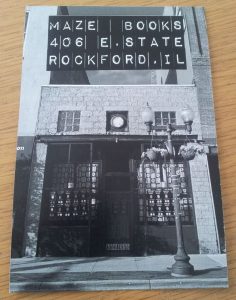
There are always little pockets where the Beat Generation writers and all those associated with them are cherished. I’m thinking of Third Mind Bookshop in Ann Arbor, Michigan – www.thirdmindbooks.com and more lately, Maze Books in Rockford, Illinois. If you live in Illinois well worth a trip. They are a used and new bookstore, general stock but with a well stocked Beat section. See this little recent picture – Thank you Dave Pedersen for putting that on Facebook. They like the Beats that much they have Beat Generation scholar Don Heneghan in over two days on October 6th and 7th for talks. www.maze-books.com
——————————————————————————————————————–
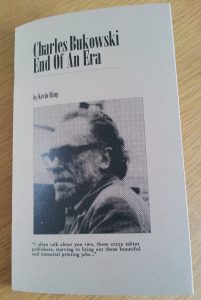 There is a new Beat Scene Press chapbook. In the regular 8″x5″ inches series format. 125 numbered copies. CHARLES BUKOWSKI: END OF AN ERA by yours truly. It examines a pivotal point in Bukowski’s life, taking him away from the past and in a new direction. If you would like to get hold of a copy on publication let me know by email at kevbeatscene@gmail.com
There is a new Beat Scene Press chapbook. In the regular 8″x5″ inches series format. 125 numbered copies. CHARLES BUKOWSKI: END OF AN ERA by yours truly. It examines a pivotal point in Bukowski’s life, taking him away from the past and in a new direction. If you would like to get hold of a copy on publication let me know by email at kevbeatscene@gmail.com
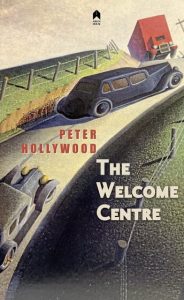 There are any number of talented people who subscribe to Beat Scene. Artists, photographers, film makers, poets, writers. One writer who I’ve grown to appreciate is based in Belfast Northern Ireland. His name is Peter Hollywood. At one time, if I remember well, he worked at Queens University Bookshop with the indomitable Joe McMeekin, who used to promote Charles Bukowski heavily in the store. Joe was so enamoured of Bukowski’s writing that he went to visit Bukowski and his wife Linda in San Pedro. I’ve seen the pictures. But I digress. Peter Hollywood has a string of books to his name. He’s a short story writer of late – there are two novels – LUGGAGE and also DROWNING THE GOWNS – and he bases his work, thus far, around his home town of Belfast and environs. The latest collection is THE WELCOME CENTRE and it doesn’t disappoint. It’s wry, subtle, couched in a way that the reader gets drawn in quickly. These are obviously characters based from real life observation and Peter Hollywood is equally adept at capturing conversations and translating them to these pages as well. He turns the mundane into comic situations, to pathos, to social comment. It’s all so – well, provocative at times. Evocative too. Northern Ireland has a troubled recent past. The last one hundred years especially in terms of civil unrest. You’ve seen the headlines. This isn’t a Beat Generation book but Hollywood, a big reader of the Beats, can’t resist recalling a night when Allen Ginsberg came to town – A BEAT BELFAST MEMOIR – that tells an out of the ordinary story. And another story has a driver called Cassady. These people quickly become real in the imagination and his telling of these stories. The cover artwork is by noted American artist Grant Wood ‘Death on Ridge Road.’ ISBN 978-1-85132-294-7 – A paperback published by Arlen House, 42 Grange Abbey Road, Baldoyle, Dublin D13 AOF3, Ireland – email arlenhouse@gmail.com
There are any number of talented people who subscribe to Beat Scene. Artists, photographers, film makers, poets, writers. One writer who I’ve grown to appreciate is based in Belfast Northern Ireland. His name is Peter Hollywood. At one time, if I remember well, he worked at Queens University Bookshop with the indomitable Joe McMeekin, who used to promote Charles Bukowski heavily in the store. Joe was so enamoured of Bukowski’s writing that he went to visit Bukowski and his wife Linda in San Pedro. I’ve seen the pictures. But I digress. Peter Hollywood has a string of books to his name. He’s a short story writer of late – there are two novels – LUGGAGE and also DROWNING THE GOWNS – and he bases his work, thus far, around his home town of Belfast and environs. The latest collection is THE WELCOME CENTRE and it doesn’t disappoint. It’s wry, subtle, couched in a way that the reader gets drawn in quickly. These are obviously characters based from real life observation and Peter Hollywood is equally adept at capturing conversations and translating them to these pages as well. He turns the mundane into comic situations, to pathos, to social comment. It’s all so – well, provocative at times. Evocative too. Northern Ireland has a troubled recent past. The last one hundred years especially in terms of civil unrest. You’ve seen the headlines. This isn’t a Beat Generation book but Hollywood, a big reader of the Beats, can’t resist recalling a night when Allen Ginsberg came to town – A BEAT BELFAST MEMOIR – that tells an out of the ordinary story. And another story has a driver called Cassady. These people quickly become real in the imagination and his telling of these stories. The cover artwork is by noted American artist Grant Wood ‘Death on Ridge Road.’ ISBN 978-1-85132-294-7 – A paperback published by Arlen House, 42 Grange Abbey Road, Baldoyle, Dublin D13 AOF3, Ireland – email arlenhouse@gmail.com
————————————————————————————————————
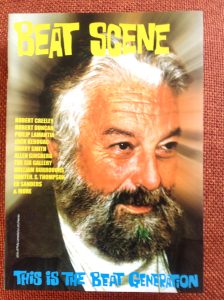 The issue of BEAT SCENE here is No 48. It was issued in October 2005. That’s Philip Lamantia on the cover. Picture taken by Larry Keenan Jr. Lamantia was one of the little band of poets who read at the famed Six Gallery reading in San Francisco in the mid 1950s. When all the poets were mere legends in their own minds. Few knew of them. Lamantia didn’t even read his own poems, instead he read the work of his recently dead friend John Hoffman. Neal Cassady and Jack Kerouac were in the crowd cheering the poets on. And, the story goes, Kerouac collected nickels to keep the crowd supplied with wine in a jug from a nearby store. From all accounts it was sometimes rowdy, more like an ecstatic jazz crowd – shouts of GO were uttered. A new dawn for American poetry. Lamantia, modest as he was that night, was at the heart of it. Lamantia features well in this issue. There are photos of him as a young surrealist style poet. That essay is followed by an exploration of that Six Gallery reading. Hunter S. Thompson, Kerouac on Broadway, Robert Duncan, Burroughs at Naropa, Robert Creeley, Chandler Brossard, an interview with Ed Sanders, Allen Ginsberg and more. And, a word about Larry Keenan Jr. As a very young man who attended classes by Michael McClure and they became friends. One day Michael called him up and asked if he’d like to come down to City Lights Bookstore and take some photos of poet friends? Larry had been trying to make a name for himself in that sphere. It was 1965. He got there and met up with Michael McClure and realised that Allen Ginsberg was there with two of the Orlovsky brothers, plus some fellow called Bob Dylan. The plan was to take pictures that, it was thought, would be used on the cover of a forthcoming Dylan LP he was calling Blonde on Blonde. But that’s another story. Beat Scene interviewed Larry about all this and more. Photographing Neal Cassady, Ken Kesey and others. Over the next few years I found Larry to be one of the nicest people I ever knew. Kind and thoughtful to a fault.
The issue of BEAT SCENE here is No 48. It was issued in October 2005. That’s Philip Lamantia on the cover. Picture taken by Larry Keenan Jr. Lamantia was one of the little band of poets who read at the famed Six Gallery reading in San Francisco in the mid 1950s. When all the poets were mere legends in their own minds. Few knew of them. Lamantia didn’t even read his own poems, instead he read the work of his recently dead friend John Hoffman. Neal Cassady and Jack Kerouac were in the crowd cheering the poets on. And, the story goes, Kerouac collected nickels to keep the crowd supplied with wine in a jug from a nearby store. From all accounts it was sometimes rowdy, more like an ecstatic jazz crowd – shouts of GO were uttered. A new dawn for American poetry. Lamantia, modest as he was that night, was at the heart of it. Lamantia features well in this issue. There are photos of him as a young surrealist style poet. That essay is followed by an exploration of that Six Gallery reading. Hunter S. Thompson, Kerouac on Broadway, Robert Duncan, Burroughs at Naropa, Robert Creeley, Chandler Brossard, an interview with Ed Sanders, Allen Ginsberg and more. And, a word about Larry Keenan Jr. As a very young man who attended classes by Michael McClure and they became friends. One day Michael called him up and asked if he’d like to come down to City Lights Bookstore and take some photos of poet friends? Larry had been trying to make a name for himself in that sphere. It was 1965. He got there and met up with Michael McClure and realised that Allen Ginsberg was there with two of the Orlovsky brothers, plus some fellow called Bob Dylan. The plan was to take pictures that, it was thought, would be used on the cover of a forthcoming Dylan LP he was calling Blonde on Blonde. But that’s another story. Beat Scene interviewed Larry about all this and more. Photographing Neal Cassady, Ken Kesey and others. Over the next few years I found Larry to be one of the nicest people I ever knew. Kind and thoughtful to a fault.
————————————————————————————–
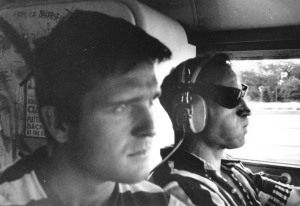
Above you’ll see Ken Babbs (left) and Neal Cassady. Cassady is driving Ken Kesey’s old school bus he called FURTHUR. Which is pretty apt considering Neal Cassady was the driver. Cassady was famous, or should that read notorious, for his sometimes daredevil, manic, sometimes reckless life behind a steering wheel. He once left an inebriated Charles Bukowski a quivering wreck after a kamikaze slalom through the streets of San Francisco. They had been drinking steadily beforehand. In the car Bukowski remembered, he wrote it in a story, that Cassady displayed no signs of having drunk at all. But he never, ever, got into a car with Neal Cassady again. The photo here is from a period which splits opinion. Cassady was not the man who was ‘Dean Moriarty’ in Jack Kerouac’s famed novel ON THE ROAD, a book which has origins in the late 1940s, a time before interstate highways had altered America irrevocably. When you could go and see Charlie Parker, Lester Young, Slim Gaillard and others in little jazz clubs, something that Neal and Kerouac lived for. Neal was in decline, physically and mentally. He died just a few short years later in Mexico in 1968. Ken Babbs was, arguably, Ken Kesey’s closest friend. He was an ex military man. He has that steely eyed gimlet look about him, don’t you think. His gaze fixed on the horizon. Neal is possibly talking. He was famous, or is that infamous, for his speedfreak monologues. Never stopping, never a second of hesitation, word association spiel. Did Lenny Bruce ever listen to tape recordings of him I wonder. Is Ken listening to Neal? There would have been a lot happening on Kesey’s bus. The rock music of the mid 1960s. EIGHT MILES HIGH by The Byrds maybe? That came out in 1966. Possibly not released yet. Or some early West Coast rock, The Charlatans, The Warlocks, later to morph into The Grateful Dead of course. John Coltrane? It’s a moment in time. And I’m wondering who took the photo? And how on earth did they take it?
—————————————————————————————————
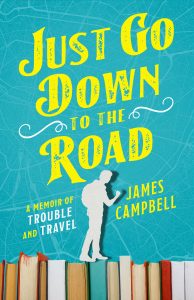
JUST GO DOWN TO THE ROAD by James Campbell
Having written this little article about James Campbell’s autobiographical book JUST GO DOWN TO THE ROAD for Beat Scene, another, more impressive, take on the book came in from Jim Burns and I quickly ditched my thoughts and inserted Jim’s words instead. You’ll read his version of events in the new Beat Scene shortly. Just for fun, I think, here’s my abandoned thoughts on James Campbells book.
“KEROUAC & CO
In this short essay, Campbell examines the writing, life-style, and philosophy of Kerouac (and the Beats, in general). He sorts out some of Kerouac’s conflicts of interest and other reversals which happened along the way.”
So says entry 430a in Robert Milewski’s Jack Kerouac: An Annotated Bibliography of Secondary Sources 1944-1979 – published by Scarecrow Press way back in 1981. He’s speaking of a Scottish literary journal edited by James Campbell in Edinburgh published in 1979.
Being totally obsessed by Jack Kerouac back then and being alerted by the Beat grapevine it was something I wanted to see and read, starved, as was often the case, in those times of anything Jack related. There was no Beat deluge at that point. So I wrote to the review and got my copy, receiving a short note from the editor James Campbell with it.
Fifteen years later his name resurfaced, at least in my world, with a book he called Paris Interzone. The book attracted my attention as it partially took in America’s Beat Generation exiles, Burroughs, Ginsberg and co, alongside figures like James Baldwin. He followed it with This Is the Beat Generation. Perhaps what intrigued me was that he was a British writer exploring a very American aspect of Post War literature. That always appealed to me. Just as the writing of Barry Miles does, it’s just a whole new take. The British understand the Beats their own way.
James Campbell has led a full life so far. From unpromising beginnings he has fashioned a writer’s career. A friendship and a biography of James Baldwin amongst a string of other books.
This against the backdrop of his day job as a columnist at the Times Literary Review and regular features for The Guardian. He has always had a place in his heart for the Beat Generation. It’s a fact that the first articles he penned for the TLS were on Robert Creeley, Ed Dorn and Gary Snyder.
Campbell’s name cropped up for me again recently when I finally caught up with his 2022 book Just Go Down To The Road. Now in my fevered imagination this immediately evoked images of Robert Johnson and other bluesmen getting down to the crossroads, probably at midnight, to strike demonic deals in exchange for Blues Magic. The actual title has no such connections, at least I don’t think so, but does relate to a key turning point in the teenage Jim Campbell’s life.
Just Go Down To The Road is autobiography, plain and simple and it must mirror so many lives of young people coming of age in the late 1960s/early 1970s. It’s a spellbinding read, full of humour, self deprecation, vivid images of working class Glasgow life. Campbell was a wayward school pupil and probably a disappointment for his caring parents in these times. But it’s always an honest account.
In amongst the travels to ‘The Land of Away’ – Greece, Israel, North Africa and so on, all on a budget of a piece of string and some bubble gum, there are stories that catch you by surprise. Remember Peter Green’s Fleetwood Mac. The real Fleetwood Mac.
But to tarry no longer. What really caught my eye, with apologies to James Baldwin, were passages centred around encounters with Alex Trocchi. Cain’s Book by Trocchi had a profound impact on the young Campbell. The Scot’s novel was carried everywhere in a rucksack by him and he’d even attempted to write partly in imitation of Trocchi. Wherever he was, a North London squat, a Greek island, he would work on it.
It is November 1972. Campbell is just back from a kibbutz in Israel. Jack Haggerty has just employed him as a writer for Glasgow University Magazine. Making a good impression and in conversation with Haggerty they were exploring ideas for new articles. They had just settled on a new name for the journal – The Moving Review – but let James Campbell take up the story, “There was an underground magazine run by Jeff Nuttall in the north of England called the moving times. Alexander Trocchi was associated with it, and William Burroughs was a contributor. I had never seen a copy, only knew that it was vaguely “underground” and the name had stuck in my mind. Jack thought about it for a few seconds, then murmured: “I like it….yes, I like it, my friend.” At these moments, you were expected to feel proud, and you did.”
Campbell, with editor Jack Haggerty’s big help, meets up with Alex Trocchi, a kind of decadent hero to him. Interviews him, meets him a number of times and in turn has contact with William Burroughs, then living in London. He expands on all this in the book. It’s a warm story. His lifelong memory of the little dog who followed him along the road reveals a decent man.
Your mission, should you choose it, is to search out a copy of James Campbell’s Just Go Down to the Road and find out more about the ‘Land of Away.’
Polygon Press – www.polygonbooks.co.uk – Paperback at £14.99 – ISBN 978-1-84697-529-5
Kevin Ring
————————————————————————————————————-
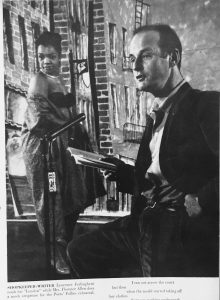 Photo here is Lawrence Ferlinghetti reading poetry with jazz backing in San Francisco’s Jazz Cellar, a regular spot for poets to collaborate with jazz musicians. The year is 1957. Ferlinghetti was a leading exponent of the fusion of jazz and poetry. There were albums issued. Alongside others like ruth weiss (she always insisted her name be lower case), Kenneth Rexroth, Kenneth Patchen, even Jack Kerouac was a sometime devotee of the art, three albums from him in the space of eighteen months as the 1950s drew to a close. Here it looks like Lawrence Ferlinghetti has quite an ensemble backing him.
Photo here is Lawrence Ferlinghetti reading poetry with jazz backing in San Francisco’s Jazz Cellar, a regular spot for poets to collaborate with jazz musicians. The year is 1957. Ferlinghetti was a leading exponent of the fusion of jazz and poetry. There were albums issued. Alongside others like ruth weiss (she always insisted her name be lower case), Kenneth Rexroth, Kenneth Patchen, even Jack Kerouac was a sometime devotee of the art, three albums from him in the space of eighteen months as the 1950s drew to a close. Here it looks like Lawrence Ferlinghetti has quite an ensemble backing him.
——————————————————————————————————————————–
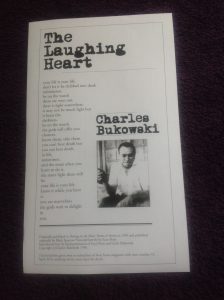
Bukowski and his The Laughing Heart poem. Found it while digging through some files, press clippings on John Fante from author, biographer Ben Pleasants from many years ago. Ben was a good friend to Beat Scene. He died a few years back sadly. He was an even bigger and closer friend to Charles Bukowski and a champion of the work of John Fante and his writer son Dan Fante. Ben, Bukowski and Black Sparrow Press editor and publisher John Martin collaborated to resurrect the novels of John Fante – what – almost forty years ago now. John Martin publishing more than half a dozen John Fante novels, Wait Until Spring, Bandini, Ask the Dust, The Road to Los Angeles, Dreams of Bunker Hill and so on. Beautifully produced books as well. Black Sparrow were always quality. John Fante was ailing by then, blind, fading away, but glad of the attention. Bukowski was afraid to meet him. John Fante had been a hero to him as a scuffling younger writer, reading him in the local libraries, it was the only place you could find his books. The bookstores certainly didn’t stock them. Bukowski was afraid his hero would disappoint him after all the passing years. And so I find the file of John Fante stuff from Ben Pleasants, but also a handful of this Bukowski broadside that went with Beat Scene almost ten years ago. Tempus Fugit. And the synchronicity of life sometimes, a young guy sends an email just this morning, he’s teaching a college course on Fante soon, he tells me. The world keeps on turning. If anyone wants one of these nice Buk things – get in touch. kevbeatscene@gmail.com
————————————————————————–
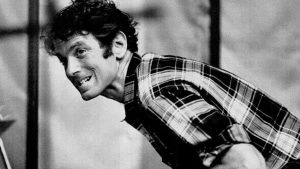
That’s DAVID WERNER AMRAM above – born 1930 – composer, musician, author too, big pal of Jack Kerouac. Here’s a photo of him as a younger man. He looks very determined about something. He must be 91 by now. And still full of beans, projects on the go, concerts to play, travelling, recording and, if reports from many, many people who know him, beaming his smile wherever he goes. A ball of energy and positivity. Banging the drum for the Beat Generation as much as he possibly can. Jack Kerouac, his big pal, in particular. An espousal of a certain humble, if you like, way of life. Almost ‘The Dharma Bums’ revisited, but wherever you are. He was, of course, the man who made the music for that little, quintessential Beat film, PULL MY DAISY and he acted in it. What was it 1959. Times when a favourite pastime of that band of writers and artists of all hues was simply to walk together through the streets of New York, Beat flaneurs maybe. Certainly there might be a party or a White Horse Tavern or a Cedar Bar at the end of that walk, but the journey was the thing, not so much the destination. A time where ‘New Visions’ were formalised, discussed. Future road trips mapped out. Ideas for new books, paintings, musical scores. David Amram is very good at harking back to those times. Read his big book OFFBEAT:COLLABORATING WITH KEROUAC – published in 2002 by Thunder’s Mouth Press. Stories of times at The Five Spot, Bickfords, Circle In The Square. Amram himself says at the beginning of this book ‘Collaborating with Kerouac was as natural as breathing.” Why the very first chapter – CHILDREN OF THE AMERICAN BOP NIGHT – is worth the admission price alone, filled as it is with 1950s recollections of Amram and Kerouac connecting initially at BYOB (Bring your own bottle) parties in the lofts and squats of New York City. Two creative souls who found a kindred spirit. That chapter is one of the best things you’ll read about the Beats, certainly in terms of the feel, the smell of the NYC streets as people got to hear about this Beat Generation. Author, biographer, Joyce Johnson, she knew both men well, says of the book ‘…a long evocation of the sweetness, energy and inspired looniness of the Beat era and the artists who changed American culture.” There’s that word again, energy, it’s so apt in describing David Amram. Did I mention his film score work, SPLENDOR IN THE GRASS, THE MANCHURIAN CANDIDATE, THE YOUNG SAVAGES, THE ARRANGEMENT and loads of others, too numerous to mention. Why he even played with a band when Jack Kerouac’s On the Road scroll was put on display at the British Library in the Autumn of 2012. Below is a picture of David (yawning), with Larry Rivers, Jack Kerouac, Gregory Corso (in white cap) and Allen Ginsberg. It’s 1959. They are taking a break from the filming of Pull My Daisy. It may be Bickfords cafe. Fred McDarrah took the photo. So that’s a painter, a musician, poets and a photographer, all conspiring to make this picture, this moment. Somehow it seems just as David Amram would want it.
———————————————————————————————
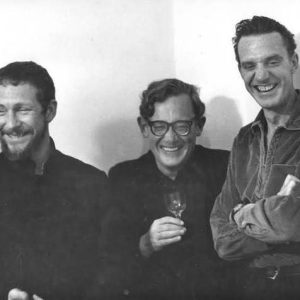 There is no other life – so goes a line in a Gary Snyder poem – where it comes from escapes me in this moment. It’ll possibly come to me at two in the morning, suddenly, out of the blue. When things don’t always go to plan it’s useful to remind myself how lucky I am. When something is not right with Beat Scene, an interview falls through, some information is not forthcoming, when a box you sent halfway around the world comes back to you inexplicably and so on etc – the thought that doing what I do – yes, Gary Snyder, you’re right – there is no other life. These books, people have given me a life that has taken me far beyond the confines of the classroom, teaching for years. Don’t get me wrong, I enjoyed teaching, but found it conservative, rigid, restricting. It was often Groundhog Day. Giving that up to become a fulltime bookseller, publisher and magazine editor – gave me that other life. Even with this hastily gathered together pile of books that were on the desk here, some of them have stories for me. Tom Waits, being at the Tropicana Motel in Los Angeles where Tom lived for a while. It was in the small hours – I didn’t get to see Tom, but there is a story. Maybe one day. Or Chris Challis and his Quest For Kerouac. Chris is long gone. Being with him in a Leicester Radio station recording his tales about Charles Bukowski and Jack Kerouac in Leicester and then publishing, can I call it mimeographing – a modest book containing one of those stories. Ted Berrigan, another long gone sadly, interviewing his son about this new book. As Ever the book of Allen Ginsberg and Neal Cassady letters, going into the publishers in Berkeley back then and picking up copies of it, hot off the press. It’s not earth shattering or life changing stuff, of course not, but it’s a life that staying with teaching would never have given me. And there’s many stories to relate. But you get the picture. In one sense Gary Snyder’s ‘There is no other life’ line is right, but in another sense he’s wrong, there is always another life for every one of us. And the name of that Snyder poem? Why Log Truck Drivers Rise Earlier Than Students of Zen. Heath Common did a terrific take on that – GARY SNYDER’S LAMENT.
There is no other life – so goes a line in a Gary Snyder poem – where it comes from escapes me in this moment. It’ll possibly come to me at two in the morning, suddenly, out of the blue. When things don’t always go to plan it’s useful to remind myself how lucky I am. When something is not right with Beat Scene, an interview falls through, some information is not forthcoming, when a box you sent halfway around the world comes back to you inexplicably and so on etc – the thought that doing what I do – yes, Gary Snyder, you’re right – there is no other life. These books, people have given me a life that has taken me far beyond the confines of the classroom, teaching for years. Don’t get me wrong, I enjoyed teaching, but found it conservative, rigid, restricting. It was often Groundhog Day. Giving that up to become a fulltime bookseller, publisher and magazine editor – gave me that other life. Even with this hastily gathered together pile of books that were on the desk here, some of them have stories for me. Tom Waits, being at the Tropicana Motel in Los Angeles where Tom lived for a while. It was in the small hours – I didn’t get to see Tom, but there is a story. Maybe one day. Or Chris Challis and his Quest For Kerouac. Chris is long gone. Being with him in a Leicester Radio station recording his tales about Charles Bukowski and Jack Kerouac in Leicester and then publishing, can I call it mimeographing – a modest book containing one of those stories. Ted Berrigan, another long gone sadly, interviewing his son about this new book. As Ever the book of Allen Ginsberg and Neal Cassady letters, going into the publishers in Berkeley back then and picking up copies of it, hot off the press. It’s not earth shattering or life changing stuff, of course not, but it’s a life that staying with teaching would never have given me. And there’s many stories to relate. But you get the picture. In one sense Gary Snyder’s ‘There is no other life’ line is right, but in another sense he’s wrong, there is always another life for every one of us. And the name of that Snyder poem? Why Log Truck Drivers Rise Earlier Than Students of Zen. Heath Common did a terrific take on that – GARY SNYDER’S LAMENT.
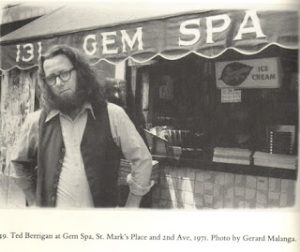
In the post this morning – IN HONOR OF TED BERRIGAN by Ed Sanders – new from Moloko/Sea Urchin in The Netherlands. An exquisite pocket paperback with very impressive production standards. Colour printing throughout, reproducing Ed’s hand script which he executes with his usual panache. It reads like one of Ed’s alternative history books, that is the real history of things, the truth, instead of media manipulation, censorship, falsehoods. And here New York poet, the late Ted Berrigan, is at the centre of it all. You can count it as one of Ed’s glyph books. I gather that the book stems from correspondence between Ed Sanders and Ron Padgett, a big poet friend of Ted’s way back. Moloko/Sea Urchin are publishing some truly magical little ‘Beat’ type things in recent times. Go here to order yourself a copy. It’s beautiful. https://www.sea-urchin.net/books/moloko-print/
————————————————————————————————
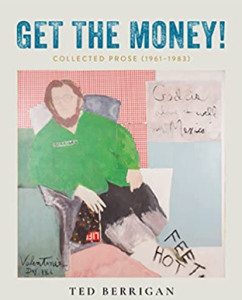
Really looking forward to Ted Berrigan’s GET THE MONEY: Collected Prose 1961- 1983 – which sees Anselm Berrigan, Edmund Berrigan, and Alice Notley perform editing duties. It’s from City Lights books this Summer. Ted is long gone sadly but his reputation seems to flourish still. Poet in the main. Is he New York School, is he a Second Wave Beat? He’s there with Aram Saroyan, Lewis Warsh, Tom Clark, Alice Notley, Frank O’Hara, Anne Waldman, Bill Berkson, Joe Brainard, all that gang. And he went to interview Jack Kerouac, along with Aram Saroyan, for The Paris Review in 1968. At Kerouac’s home. Jack was wary of visitors but seems to have warmed to Berrigan and Saroyan – especially as he was so keen on William Saroyan’s writing way back. Aram’s father of course. Tom Clark was supposed to have accompanied them to Jack’s house, but for reasons I’ve never quite understood never made it. Ted was equally at home with prose, though his reputation is largely built around his quirky, irreverent, quickfire poetry. Of that era and that particular group of poets he, perhaps, is the one that attracted the most in terms of a wider popular appeal.
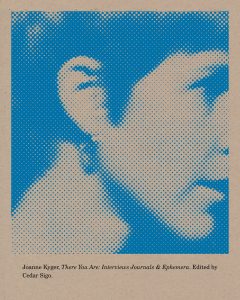
Thinking about this Ted Berrigan book, getting into it – the whole thing reminded me of a recent Joanne Kyger book of notes, journals, ephemera, abandoned poems, photos, letters. It is THERE YOU ARE, published by Cedar Sigo and the gang at Wave Books. And also of the Philip Lamantia book PHILIP LAMANTIA: PRESERVING FIRE – SELECTED PROSE, issued by City Lights, again, his prose, fragments, reviews, letters and whatnot. The Ted Berrigan book is very much like that. And early on what emerges in this Berrigan book is collaboration and community. Berrigan, it seems even more so here, was always intent on him and his friends, Ron Padgett, Joe Brainard and company, helping each other, mutual aid, whether it be a magazine experiment like the publication ‘C’ in the 1960s, that working in unison, tandem, with his pals, equally talented, quick witted, inventive, working with virtually no funds, but having a go, having fun with it in the creation. Much like Wallace Berman did or Leroi and Hettie Jones with Yugen a few years earlier, a collective in all cases, with common aims. I’m only 50 pages into this Berrigan collection and the energy just bounces up at you. I know Ted took pills and drank a lot of Pepsi, maybe that was his secret to never sleeping. Can’t wait to get back into it. And while reading it I’m drinking hot red berry tea from this mug kindly sent to me years ago. It’s been sitting on a bookshelf for nineteen years. I’ve forgotten the names of the people involved but they were a community of writers, artists, poets, film makers etc that did a few of these On the Road reading events in this old hotel – The Grand Midway Hotel – they repurposed around twenty years ago and more. Got the feeling they were young kids. I’m hoping they kept alive their youthful idealism and are still as lively.
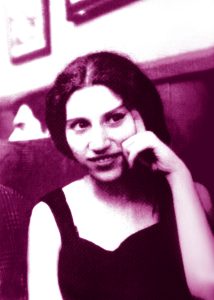 In a lull after the slog that was the Beat Scene 103 mailout, a new edition of Diane di Prima’s Revolutionary Letters is in my hand. Not, I hasten to add, the City Lights edition, that one’s fine and dandy, but a UK edition through Silver Press. Intrigued that it has TWO introductions. Read them both and they are extended essays, not simply a half page formality. And these intros spell out the interests, projects, aspirations, dreams and achievements of di Prima. And, as a little aside, I’d forgotten how early on she altered the spelling of her surname from DiPrima to di Prima, simply to accentuate the Italian side of her family background. She was an anarchistic, political animal, but in more ways than the routine politics that we all know and hate. In her very way of living. The IMAGINATION was everything to Diane and that comes out so vehemently in REVOLUTIONARY LETTERS, mini manifestos kind of. They were an ongoing aspect of a life, she continually wrote them, updated them. One of the intros here records that she was writing more of them as she was in fading health a few years ago. She died in 2020. She began writing them in 1968. That was a big year globally, but in America especially. She was into alchemy, John Dee, The Diggers, Audre Lorde, radical theatre, printing, you name it, she was so much more than a poet. Go to www.silverpress.org
In a lull after the slog that was the Beat Scene 103 mailout, a new edition of Diane di Prima’s Revolutionary Letters is in my hand. Not, I hasten to add, the City Lights edition, that one’s fine and dandy, but a UK edition through Silver Press. Intrigued that it has TWO introductions. Read them both and they are extended essays, not simply a half page formality. And these intros spell out the interests, projects, aspirations, dreams and achievements of di Prima. And, as a little aside, I’d forgotten how early on she altered the spelling of her surname from DiPrima to di Prima, simply to accentuate the Italian side of her family background. She was an anarchistic, political animal, but in more ways than the routine politics that we all know and hate. In her very way of living. The IMAGINATION was everything to Diane and that comes out so vehemently in REVOLUTIONARY LETTERS, mini manifestos kind of. They were an ongoing aspect of a life, she continually wrote them, updated them. One of the intros here records that she was writing more of them as she was in fading health a few years ago. She died in 2020. She began writing them in 1968. That was a big year globally, but in America especially. She was into alchemy, John Dee, The Diggers, Audre Lorde, radical theatre, printing, you name it, she was so much more than a poet. Go to www.silverpress.org
—————————————————————————————–
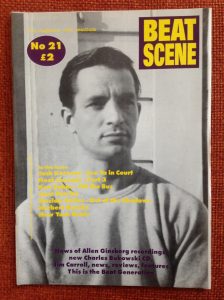 August 1995. What were you doing? Did you even exist? Publishing Beat Scene makes it easy to recall times, places and people for me. Beat Scene No 21 was published that month. A black and white photograph of a young Jack Kerouac on the front cover. It was in the days when the magazine was distributed by two big companies to stores around the world, America, Australia, Japan, literally everywhere. It was in stores around the UK. W.H. Smith, record stores, lots in London naturally and, of course, the wonderful much missed Compendium Bookstore in Camden Town. How I miss my cup of coffee in the basement with Chris Render as he handed me a cheque every time without fail. And Mike Hart with his insider knowledge at the front desk. ‘Kev, I’ve put this pile of books aside for you, thought you’d want them’. And Mike was always right. New copies of American poets, that mostly never made it north of Watford. Kerouac, Kenneth Patchen, some obscure Snyder thing or Bukowski and so on. London has always been a separate country. Miss those two blokes. Compendium sold hundreds of copies for me. Chris was a very principled bloke. Could be gruff at times if extra busy. But behind that a nice bloke. There were thousands of that issue and today Wednesday, April 6 I sold the very last copy I have. Almost twenty seven years ago. Inside were Jane Bowles, troubled wife of Paul. There was William Everson, William Burroughs, part three of a big feature on Neal Cassady, an interview with Sinclair Beiles – remember MINUTES TO GO with Gysin, Corso, Burroughs and Beiles? Herbert Huncke was in the mix, an interview with Ken Kesey’s sidekick Ken Babbs, Allen Ginsberg and Jack Kerouac. Richard Brautigan was the back cover – he was loading mercury with a pitchfork. Now I can consign it to the distant past. Back then I still had a day job teaching. It was busy with two hungry children to feed. Where did I find the energy? Nowadays the print run is a lot less. And I sell every copy personally. It makes life saner for me, but the fun of it all remains. Beat Scene has always striven to be ‘popular’ – that is thorough, detailed, enthusiastic and an alternative to academic. I’d like to think I’ve stuck to that ideal. When I think of Beat Scene I think of Yugen, that wonderful little short lived magazine issued by Hettie and Leroi Jones, of Gargoyle put out by Rick Peabody in Washington DC, of Palantir put out by Jim Burns in England, Joy Walsh with Moody Street Irregulars, even Comstock Lode – again in England, Pete Frame’s Zig Zag. They all had a spark of the enthusiast, that disregard for the rules. They did what they wanted, how they wanted. And they were the better because of that attitude. Thank you to the few thousand who bought a copy of Beat Scene 21 over those long years. Wherever you are.
August 1995. What were you doing? Did you even exist? Publishing Beat Scene makes it easy to recall times, places and people for me. Beat Scene No 21 was published that month. A black and white photograph of a young Jack Kerouac on the front cover. It was in the days when the magazine was distributed by two big companies to stores around the world, America, Australia, Japan, literally everywhere. It was in stores around the UK. W.H. Smith, record stores, lots in London naturally and, of course, the wonderful much missed Compendium Bookstore in Camden Town. How I miss my cup of coffee in the basement with Chris Render as he handed me a cheque every time without fail. And Mike Hart with his insider knowledge at the front desk. ‘Kev, I’ve put this pile of books aside for you, thought you’d want them’. And Mike was always right. New copies of American poets, that mostly never made it north of Watford. Kerouac, Kenneth Patchen, some obscure Snyder thing or Bukowski and so on. London has always been a separate country. Miss those two blokes. Compendium sold hundreds of copies for me. Chris was a very principled bloke. Could be gruff at times if extra busy. But behind that a nice bloke. There were thousands of that issue and today Wednesday, April 6 I sold the very last copy I have. Almost twenty seven years ago. Inside were Jane Bowles, troubled wife of Paul. There was William Everson, William Burroughs, part three of a big feature on Neal Cassady, an interview with Sinclair Beiles – remember MINUTES TO GO with Gysin, Corso, Burroughs and Beiles? Herbert Huncke was in the mix, an interview with Ken Kesey’s sidekick Ken Babbs, Allen Ginsberg and Jack Kerouac. Richard Brautigan was the back cover – he was loading mercury with a pitchfork. Now I can consign it to the distant past. Back then I still had a day job teaching. It was busy with two hungry children to feed. Where did I find the energy? Nowadays the print run is a lot less. And I sell every copy personally. It makes life saner for me, but the fun of it all remains. Beat Scene has always striven to be ‘popular’ – that is thorough, detailed, enthusiastic and an alternative to academic. I’d like to think I’ve stuck to that ideal. When I think of Beat Scene I think of Yugen, that wonderful little short lived magazine issued by Hettie and Leroi Jones, of Gargoyle put out by Rick Peabody in Washington DC, of Palantir put out by Jim Burns in England, Joy Walsh with Moody Street Irregulars, even Comstock Lode – again in England, Pete Frame’s Zig Zag. They all had a spark of the enthusiast, that disregard for the rules. They did what they wanted, how they wanted. And they were the better because of that attitude. Thank you to the few thousand who bought a copy of Beat Scene 21 over those long years. Wherever you are.
———————————————————————————–
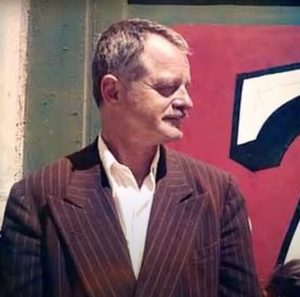
The late poet Kenneth Rexroth always intrigued me. Bombastic, opinionated, sometimes vindictive and a savage writer really and often a man who put the cat among the pigeons. To me he seemed to delight in it. Provocative, seemingly spoiling for a fight any time of day or night, he threw out reviews like grenades and waited for the fallout. A prolific writer of his own poetry, reader of his own poetry (sometimes with jazz backing), a critic, translator, reviewer, social critic, mentor to many young aspiring, unheard of poets, Allen Ginsberg, Jack Kerouac, Gary Snyder, Philip Lamantia and countless others came to his regular gatherings at his home in San Francisco in the 1950s, and earlier than that. He famously championed the Beat Generation writers for a brief period. Ginsberg, Kerouac in particular, and then fell out with him very much, partly because of a domestic incident involving Robert Creeley and, by association, the younger Jack Kerouac. And then Kerouac became the worst of the worst in Rexroth’s eyes. See what I mean about vindictive and abrasive. Sometimes curmudgeonly. Rexroth devoted some considerable time to ripping into Kerouac later on. Nevertheless Rexroth could be quite brilliant in his poetry. Direct with an unerring eye for important detail. Uncluttered, though he was well read, he wore his learning lightly. Tidying up and searching for something in the past few days I rediscovered this Watershed cassette tape of a Kenneth Rexroth reading. Lawrence Ferlinghetti and Philip Whalen were in the same series. In the days when cassettes were state of the art. My copy plays just as well as when I last left it, about twenty years ago and is a joy to listen to all over again. Rexroth featured prominently in Beat Scene 102, the second Beats in Britain volume, His travels in this country, well, England and Wales in the very late 1940s. And he will be featured once more – another British connection – in Beat Scene 104. He’s thunderously just as bombastic and deeply opinionated here also. It makes him such a good read, he’s never dull.
——————————————————————————–

David Meltzer’s new book ROCK TAU will be published by Lithic Press very shortly. We ran a short extract from it in a recent issue of Beat Scene. We hope to feature the book in the magazine in due course. No picture available right now. Lithic are an ever developing small press, books from them in recent times include Jack Micheline’s ON VALENCIA STREET and Neeli Cherkovski’s ELEGY FOR MY BEAT GENERAION (see Neeli above) amongst a whole roster of books by poets old and new. You might recall Neeli edited an impressive book WHITMAN’S WILD CHILDREN many years ago. That book featured a number of Beat poets. Wish it were back in print. Neeli also co edited a one shot poetry magazine with his pal Charles Bukowski. Neeli also wrote a biography of Bukowski, plus any number of his own poetry titles from his base in North Beach. It is heartening to see there are still real print books being issued by brave publishers. If this new David Meltzer is half as impressive as their Micheline title, both in content and production standards, then readers of Meltzer’s poetry are in for a treat. There are countless digital sites who, in their way, serve us well, yet the printed page is still vital. I’d put Lithic alongside Wave Press, a Seattle press who have, amongst other titles, issued works by Joanne Kyger, Philip Lamantia and Philip Whalen, John Wieners, Anselm Berrigan and more . Go to https://www.lithicpress.com/
For Wave go to – https://www.wavepoetry.com/

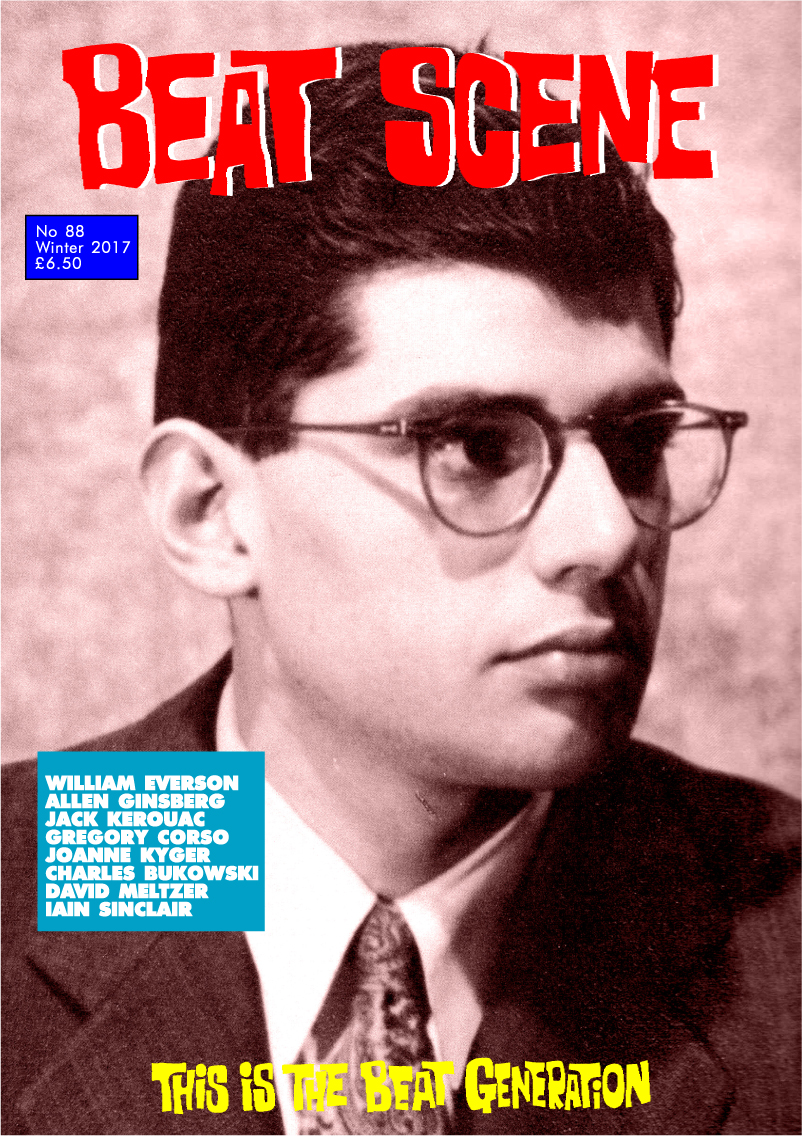
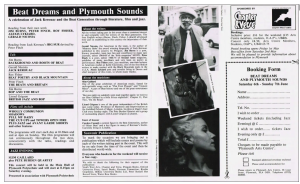
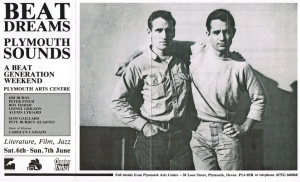
 Wanted to draw your attention to this listing of the current issue of Beat Scene. Number 110. That’s William Burroughs sidekick Brion Gysin on the front cover. The words below are taken from the always copious and fulsome digital pages of Third Mind Books. They are a bricks and mortar REAL bookstore in Ann Arbor, Michigan in the USA. Arthur Nusbaum and his team have created quite a place. They stock all Beat Scene publications, including the little books we publish. Their book descriptions are scrupulous. Digitally you will find them at
Wanted to draw your attention to this listing of the current issue of Beat Scene. Number 110. That’s William Burroughs sidekick Brion Gysin on the front cover. The words below are taken from the always copious and fulsome digital pages of Third Mind Books. They are a bricks and mortar REAL bookstore in Ann Arbor, Michigan in the USA. Arthur Nusbaum and his team have created quite a place. They stock all Beat Scene publications, including the little books we publish. Their book descriptions are scrupulous. Digitally you will find them at